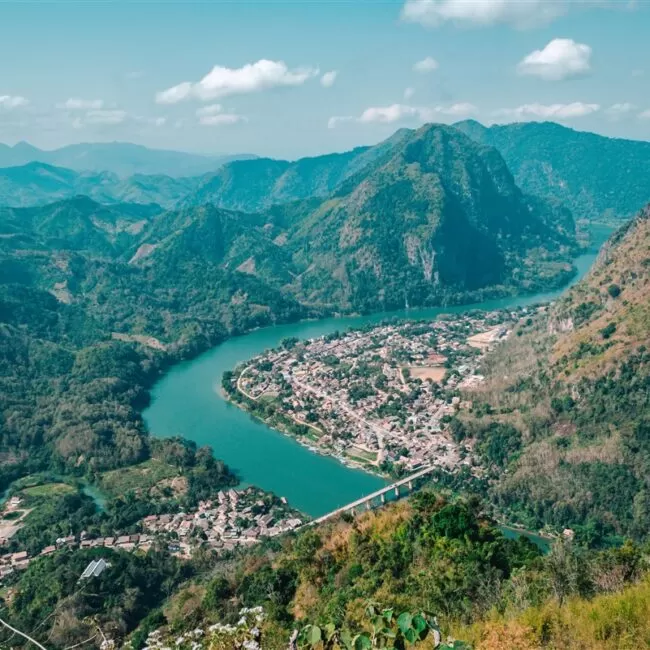

Have you been wanting to travel to Colombia but you’re unsure if it’s a good country to visit as a vegan? Are you wondering about hidden condiments in the food, the excessive amount of meat that seems to be on every menu, and that you will have to live on plain rice on the Colombian Caribbean Coast? Fear not. I have spent two months exploring this wonderful country and I can tell you that you won’t have trouble finding vegan food, even in more remote places! Here is everything I learned about traveling as a vegan in Colombia!
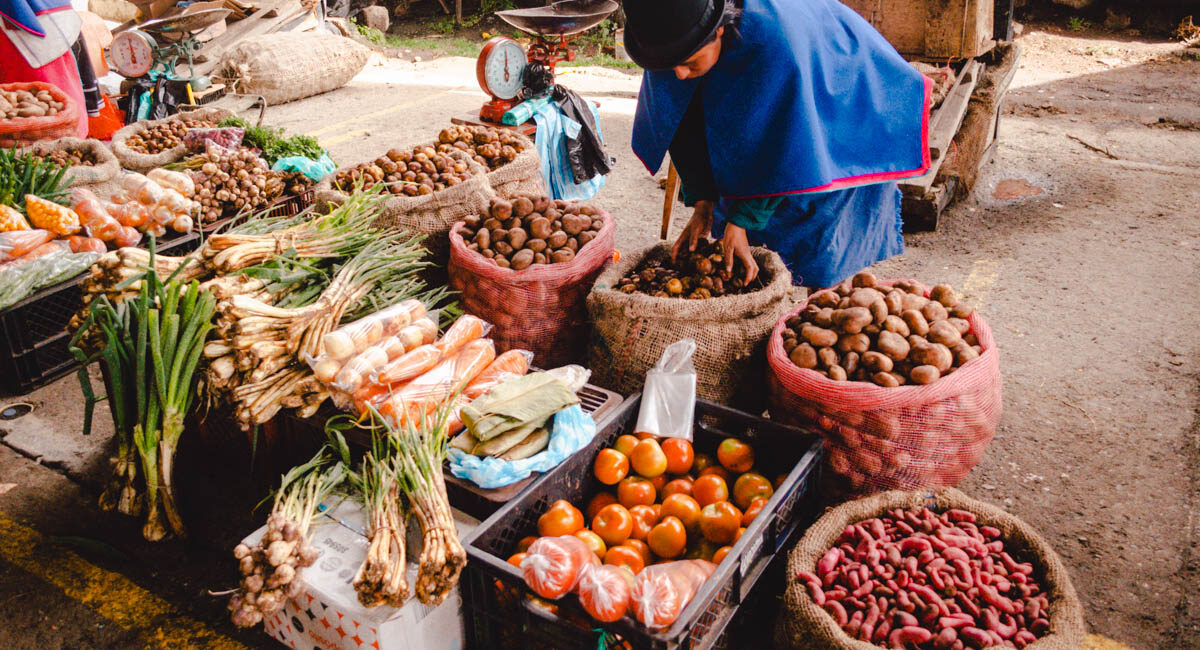
Guambiano woman selling goods at the market in Silvia
When you first think of Colombian food or Latin American food in general, big plates with rice, beans, and lots of meat probably directly come to mind. Bandeja Paisa, empanadas, and sancocho or just a few dishes that are traditionally Colombian and it’s true: they all contain pork, beef, or chicken.
What is also a fact however about Colombia is that its food culture is as diverse as its landscapes. Along the coast, you can find tropical seafood dishes with coconut rice while the Andean regions come with more hearty dishes like Ajiaco for example, a typical chicken and potato soup from Bogota.
Furthermore, street food is an important part of everyday life in Colombia. Most Colombians make a stop at an arepa stall in the morning to have breakfast and empanadas, Papas Rellenas, and colorful fruity drinks can be found at most street corners.
Colombians also love dining out and love taking their time to do it! During the weekends, and especially during the holiday season, restaurants can get packed with locals and domestic tourists.
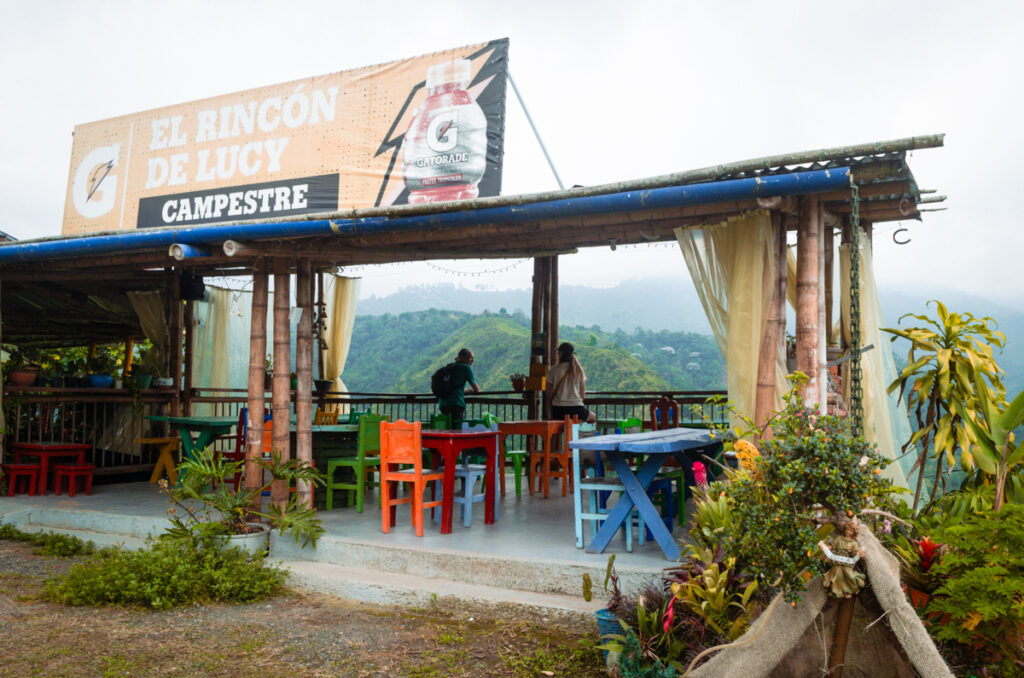
Local restaurant in the Salento coffee region
When you read the section above, it’s clear that Colombian cuisine focuses heavily on meat and dairy products. But, on the other hand, due to its great biodiversity, Colombia is also one the best countries in the world to find a wide variety of fruits and vegetables.
Colombian fruits are abundant and you can find items here that you have probably never tasted before like Nispero, Zapote, and Cherimoya.
You can find many exclusively vegan restaurants in Medellin and Cartagena and there’s also a great vegan food scene in Bogota offering traditional Colombian fare for plant-based foodies.
Even in smaller cities and towns like San Agustin, Minca, and Salento, vegan food is on offer in restaurants that cater specifically to vegans.
But, that said, it can be trickier to find vegan food in more remote areas. When I visited Dibulla on the Caribbean coast and Playa de Belen near Estoraques National Park, I feared that I would have to live on rice, beans, and fruit for days on end. But, after properly researching, even in these places, there was a variety of vegan food available.
I wrote this guide to help you navigate the Colombian food landscape a little more easily as there are a lot of things to know about Colombian food and how local dishes can easily be veganized!
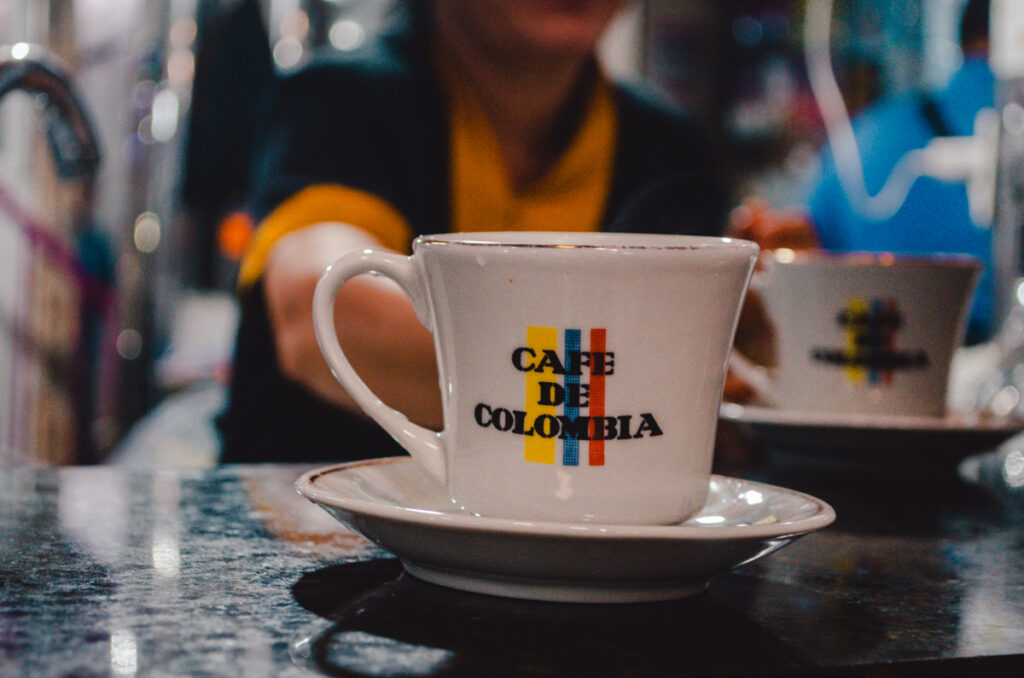
Tinto coffee at Casa de Mercado, San Gil, Colombia
When you are traveling to Colombia as a vegan, it’s important to know some key lingo to express your plant-based dietary preferences. Maybe your Spanish is great but mine certainly is not!
In that case, the best thing to do to make sure that you order food that is 100% vegan is to have a few pre-written sentences on your phone that describe what you don’t eat.
Google Translate is great for this but you have to retype it again and again which is quite annoying. Here is what I use to explain myself in Spanish. You can screenshot it and save it on your phone. That way you can easily check it whenever you are at a restaurant where little English is spoken!
“I am a vegan. I don’t eat meat, fish, pork, or chicken. I also don’t eat milk, butter, eggs, cheese and honey.”
Put it in Google Translate and you will be good to go! It will look like this:
“Soy vegano(a). No como carne, pescado, cerdo, o pollo. Tampoco consumo leche, mantequilla, huevos, queso ni miel.”
Secondly, you also have to double-check in some places that they understood you correctly or don’t try to trick you. At some restaurants, they have little knowledge of vegan eating habits.
I experienced it more than once when I ordered a vegetable soup, that they removed the chunks of meat from the soup and served it to me claiming it was solely made from vegetables!
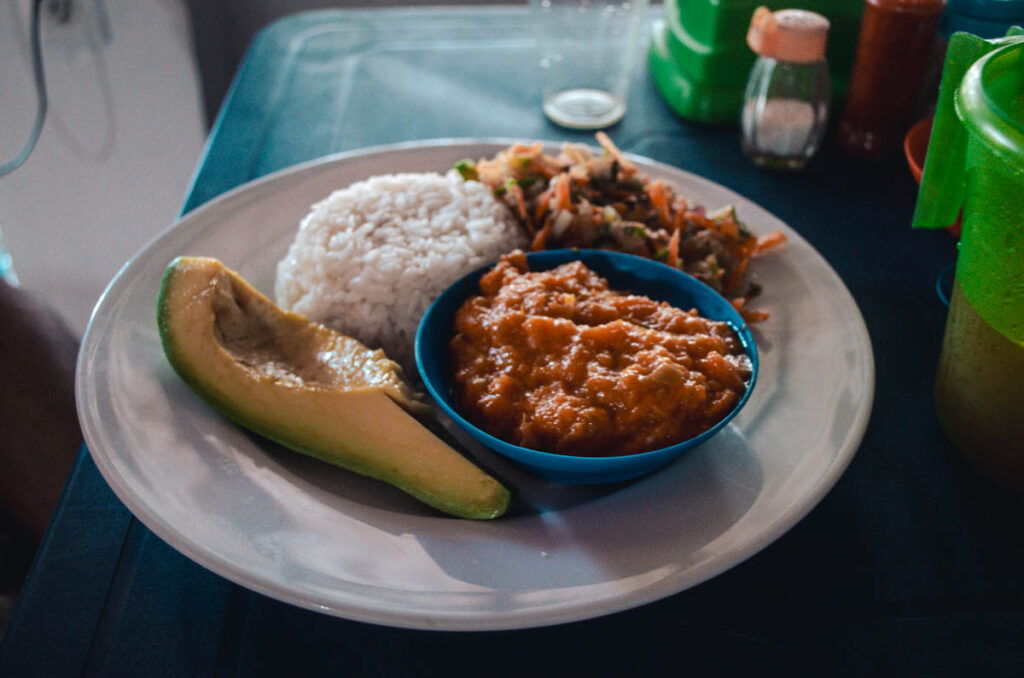
Vegan Colombian dish at a local restaurant in Villavieja near the Tatacoa desert
No, vegan food in Colombia is not expensive, especially when you compare it to Western standards. I had no trouble finding decent vegan meals in Colombia and I was able to find them for as little as 9000 COP (€2/$2,50).
Of course, a lot depends on your travel style. If you fancy going out to upscale vegan restaurants in Bogota, it’s needless to say that this will cost much more.
Traditional Colombian restaurants often offer a cheap Menu del Dia around lunchtime. This is your best bet if you want to save money. You will get a meal that consists of soup and a main plate often accompanied by a drink and dessert.
Prices for this can vary depending on the restaurant and location but, generally, they are priced somewhere between 12.000 and 25.000 COP.
As for finding vegan food in supermarkets, this tends to be a bit on the expensive side according to Colombian Standards. Plant-based milk is widely available, even in smaller towns and tofu can be found in bigger cities. A one-liter bottle of oat milk cost 9000 COP (€2/$2,50) at the Exito supermarket when I was staying in Medellin.
→ Also read: A Comuna 13 tour in Medellin: What You Need to Know
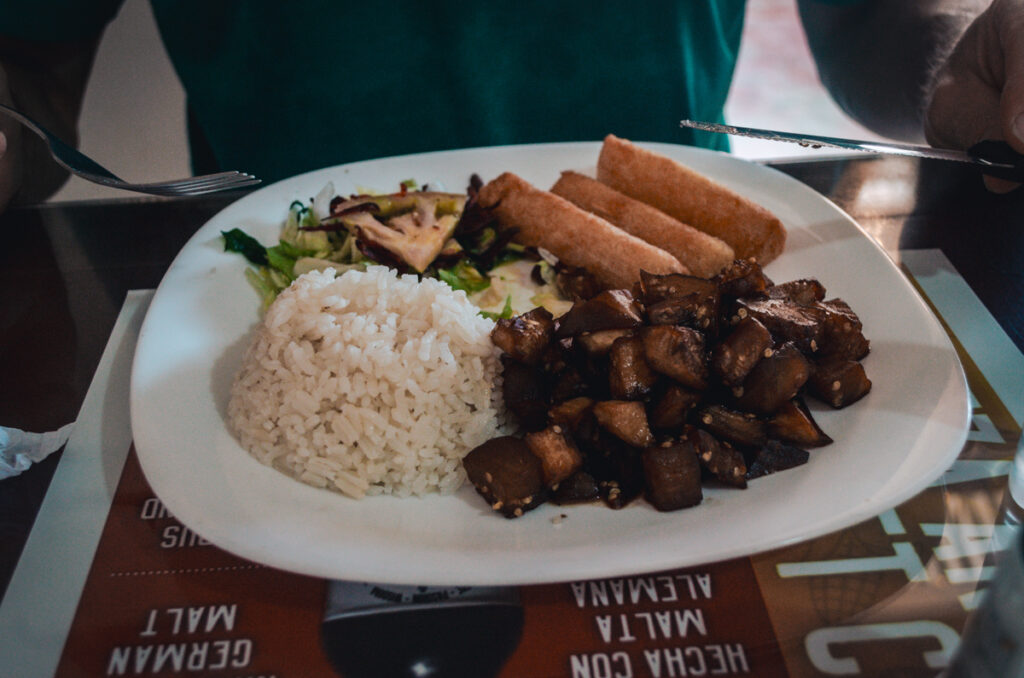
Vegan plato principal at Cristi restaurant on the way to Marinka Waterfalls in Minca
To give you a deeper understanding of what you can expect as a vegan when traveling to Colombia, I made a list of all the vegan Colombian foods I came across during my journey.
I have arranged the dishes by meal, from breakfast to dinner and I also included some snacks and drinks that are worth trying.
Lastly, at the end of the post, I’ll give you some tips on vegan accommodation and tours and provide you with a list of my favorite restaurants in Colombia that cater to vegans!
A typical Colombian breakfast mainly consists of arepa with eggs and coffee or hot chocolate, arepas with cheese on the go from street stalls, or leftover rice and beans from the day before.
I found that vegan breakfast options were one of the hardest things to find in Colombian restaurants (outside of big cities) and therefore opted mostly to prepare them myself.
Oat milk and oatmeal are very easy to find in Colombia and nuts and seeds too. Add some fresh fruit from the local market and half an avocado and you are good to go!
Below, you can find the breakfast dishes that I did encounter on my journey. Most of the items were prepared by our amazing host Nicolas from Casa Rojas Homestay in Bogota.
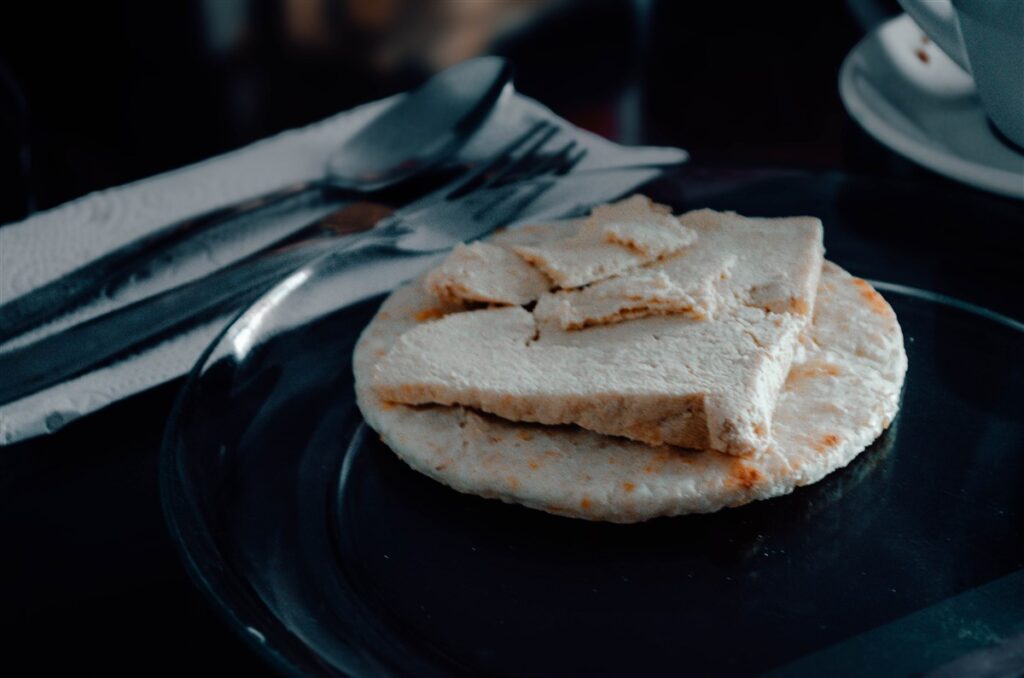
Vegan arepa prepared by a host family in Bogota, Colombia
Arepas are a staple dish in Colombia. They are round flatbreads made from cornmeal and are used as a base for a variety of dishes. They are often baked and topped with cheese at street food stalls or are a side dish to a main plate.
The arepa in the photo was made by our host Nicolas in Bogota and he topped it with a slice of homemade tofu cheese.
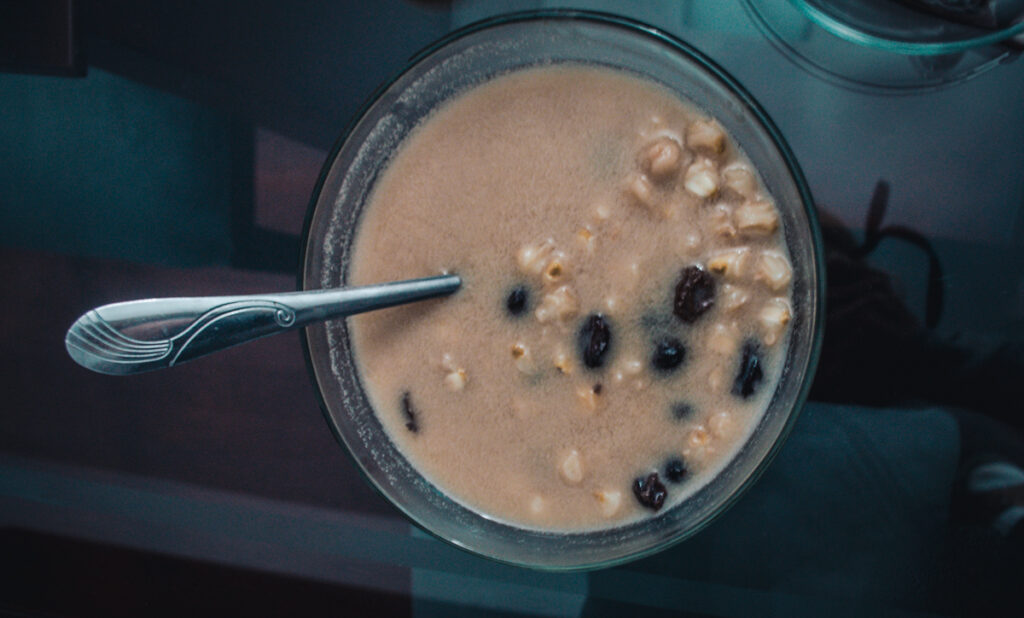
Sweet plant-based mute soup
Another incredible breakfast dish that was served by our host Nicolas in Bogota was this warm plant-based mute soup. Mute is a type of processed corn that you can find at local markets in Colombia.
The process is called nixtamalization and it softens the corn while also enhancing its nutritional value. The mute soup we were served had a nut milk base and was cinnamon-flavored. Delicious!
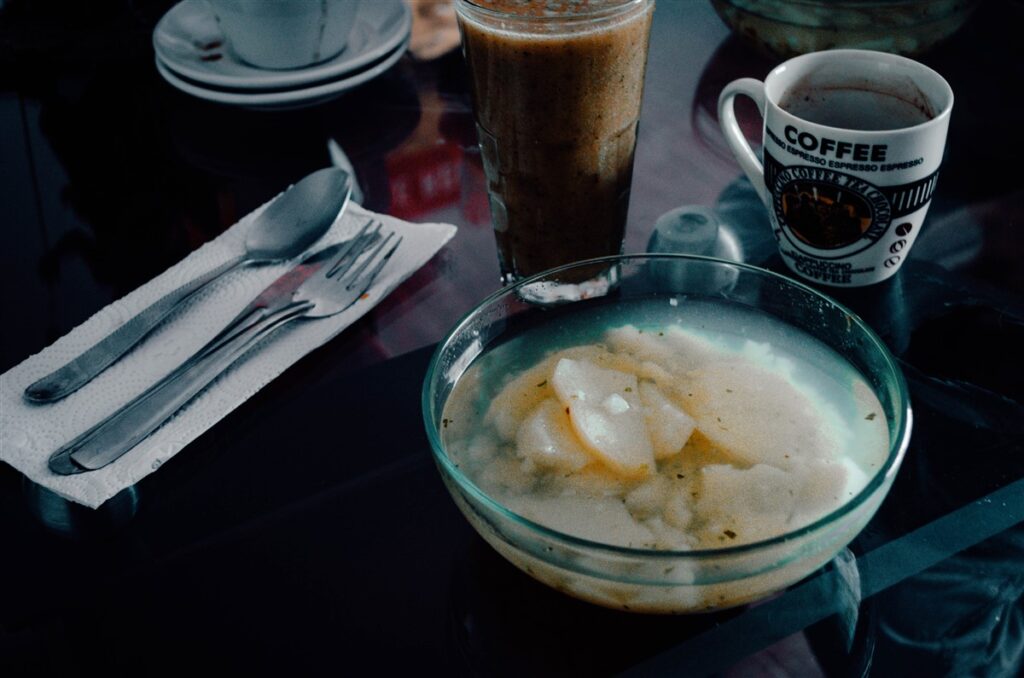
Vegan Colombian Potato soup
This vegan potato soup seemed to be a light version of a traditional Bogotian soup called Ajico. Ajico is generally a hearty potato soup prepared with large chunks of corn and meat.
This potato soup however seemed to be a stripped version of Ajico, containing only potatoes and the lovely unique taste of Guasca, a herb from the Galinsoga Parviflora plant (potato weed).
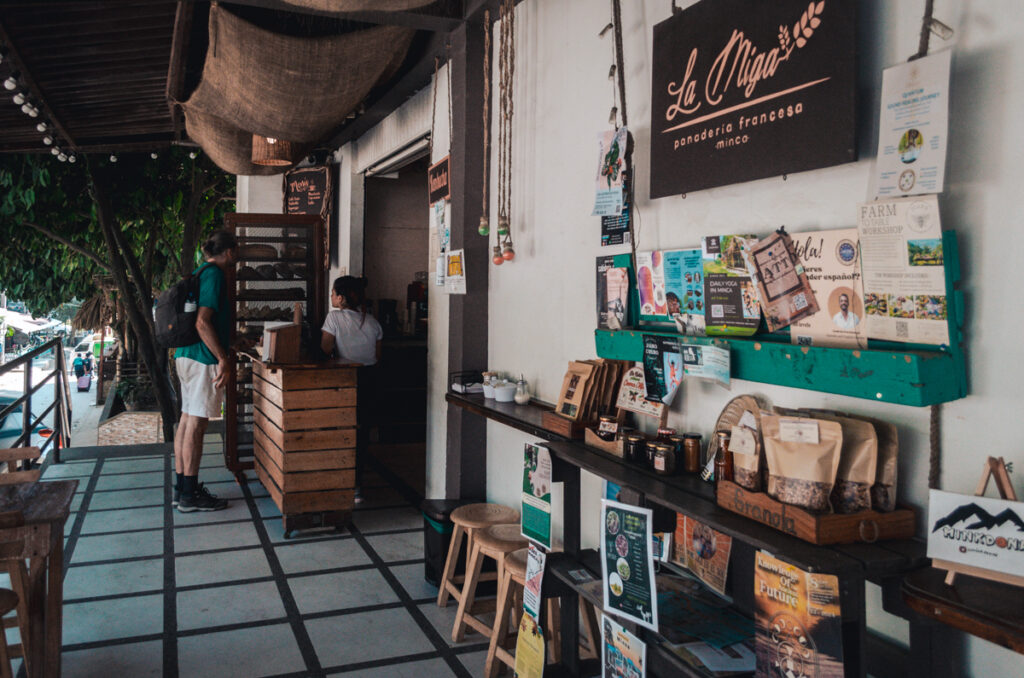
La Miga Bakery, Minca, Colombia
If vegan options for breakfast are sparse in the location you are staying a DIY breakfast is the best option. Local panaderias are everywhere in Colombia but be careful, most of the breads sold here contain cheese. Inquire about what options are suitable for vegans.
Plant-based milk, oatmeal, fruits, nuts, and seeds are also widely available.
In Colombia, lunch is referred to as “Almuerzo”. It’s the most important meal of the day in Colombia and is a significant part of Colombian culture.
It is served as a “Menu del Dia” or “Menu Ejecutivo” in restaurants and most of the time consists of a soup (sopa), a main plate (plato), a drink (bebida), and a small dessert (postre).
Colombian menu del dias are available both in traditional Colombian restaurants as well as in restaurants that specifically cater to vegans and vegetarians.
Below, I’ll first get into what you can expect at regular Colombian restaurants. After that, I will continue with what’s on offer at Colombian restaurants that are focused on plant-based food.
Colombian soups are an integral part of the Colombian food culture. The most iconic soups you can find in Colombia are Ajiaco (potato soup from Bogota), Sancocho (hearty soup with plantain, yucca, and corn), and Cazuala de Mariscos (a seafood soup with coconut).
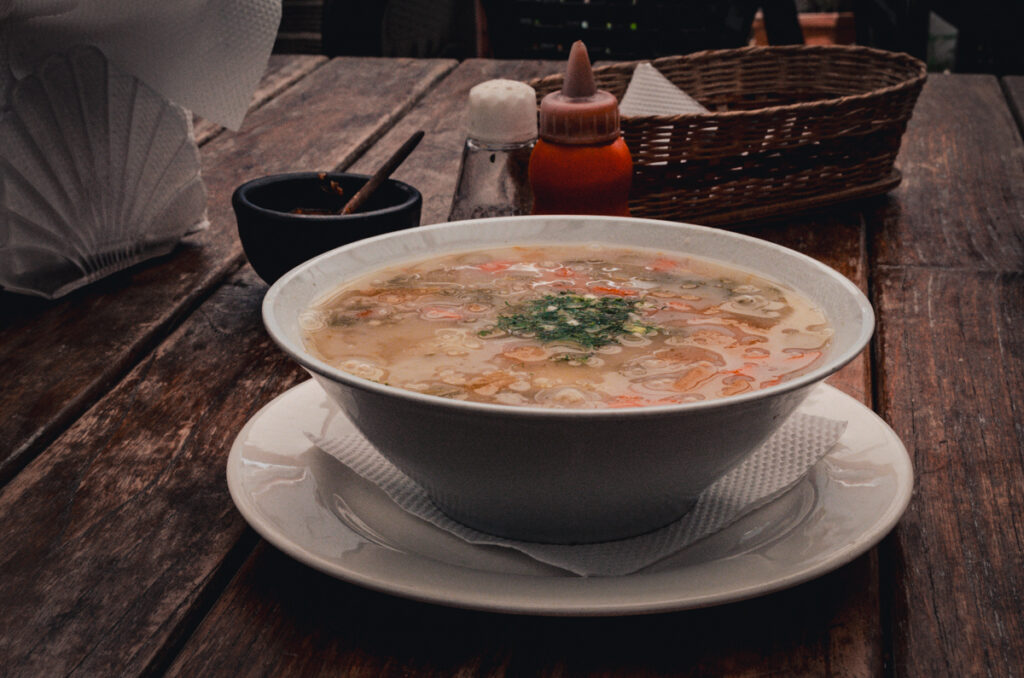
Vegan vegetable soup at Estacion 20 03, Villa de Leyva, Colombia
All the traditional soups mentioned above contain meat or fish but, for almuerzo, it seemed that the soups that were included in the menu del dias were simplified versions of the famous traditional soups. And the best thing: most of them were 100% vegan.
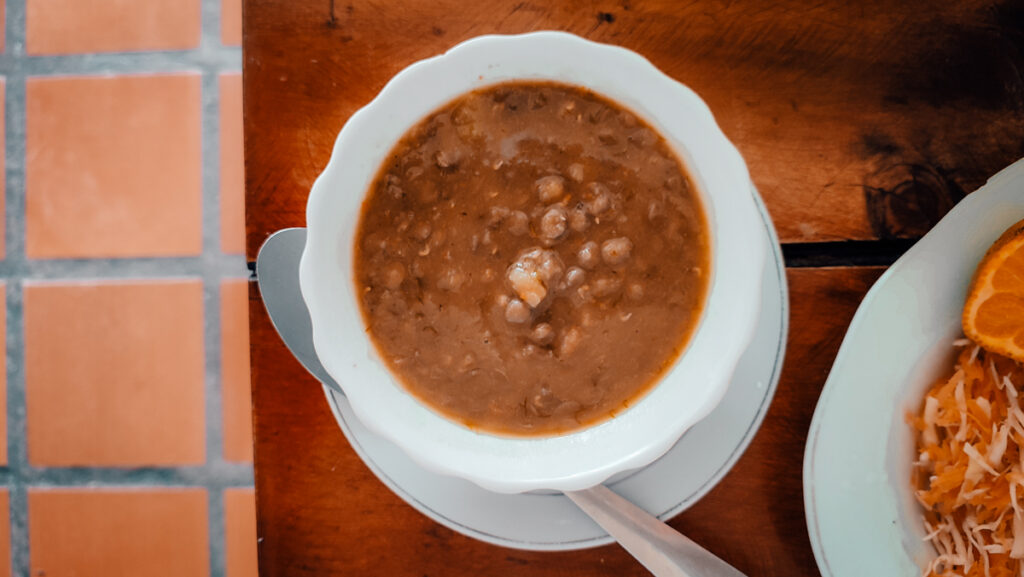
Vegan red bean soup
The most common type of soup that we were served at traditional Colombian restaurants was vegetable soup that often contained chunks of potato, corn, and/or yucca. The ingredients varied greatly and the taste too since every restaurant has its own recipes.
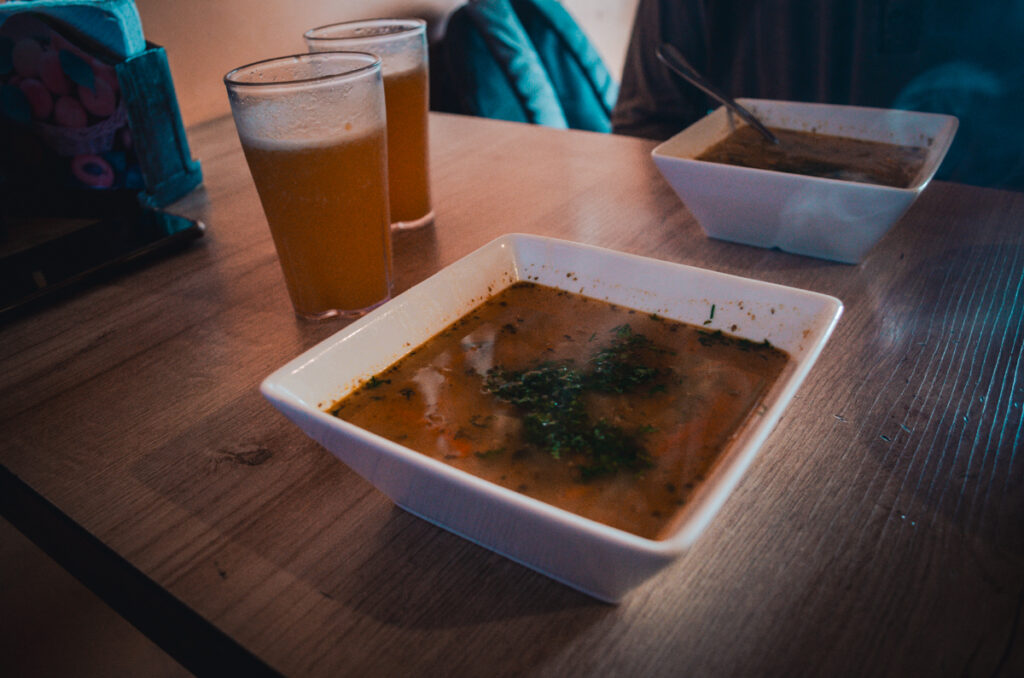
Vegetable soup with a Mediterranean touch in Salento
Another soup that is 100% vegan most of the time is the red bean soup. This soup is made from red beans and is a great source of protein but do note that red beans are served with almost every main meal in Colombia.
Whenever I had a choice for soup I would opt for another one since the red beans can easily get too much if you eat it daily as a foreigner.
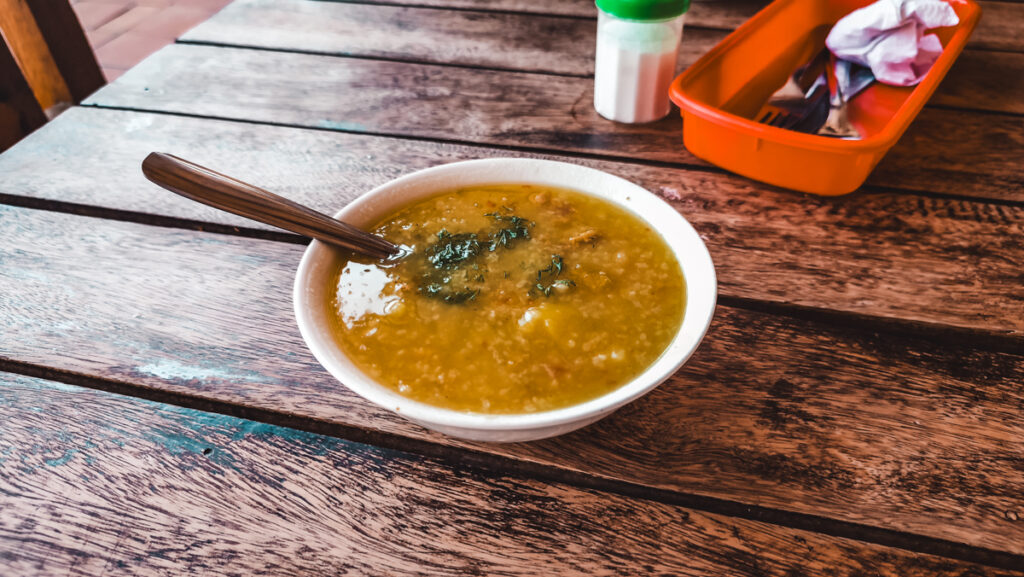
Maize and rice soup
Furthermore, there were a lot of variations. Sometimes the soups contained rice whereas other times it was a thick soup of ingredients that were mixed together.
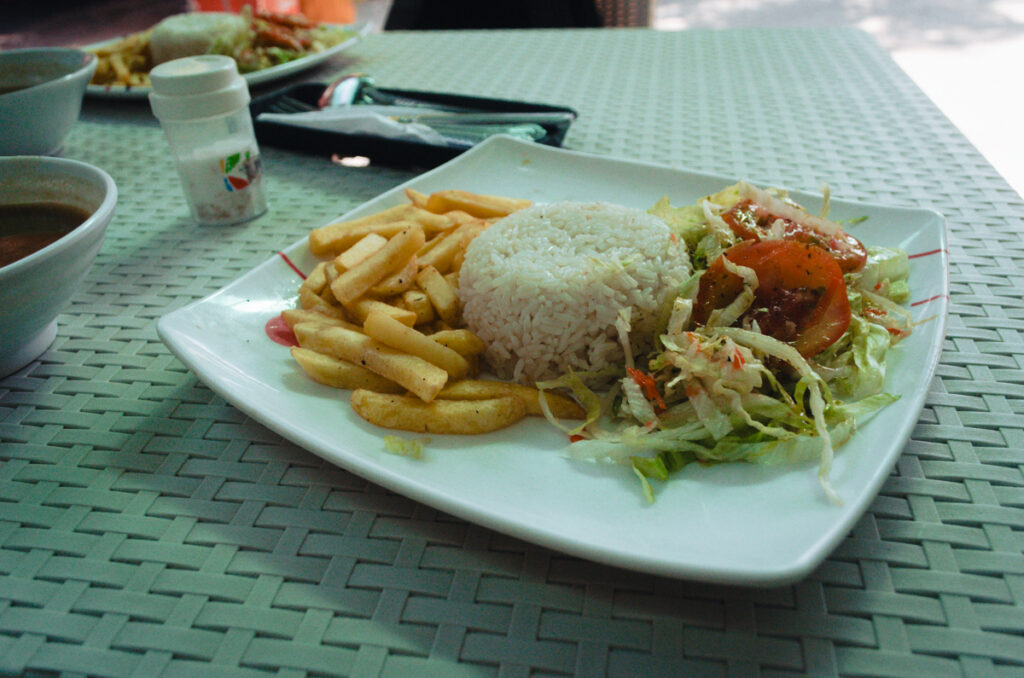
The main plate of a menu del dia is the highlight of the meal usually containing a source of protein (meat or fish), carbohydrates (white rice but often also potatoes), beans or lentils, vegetables (salad or boiled vegetables), and yucca or platano on the side.
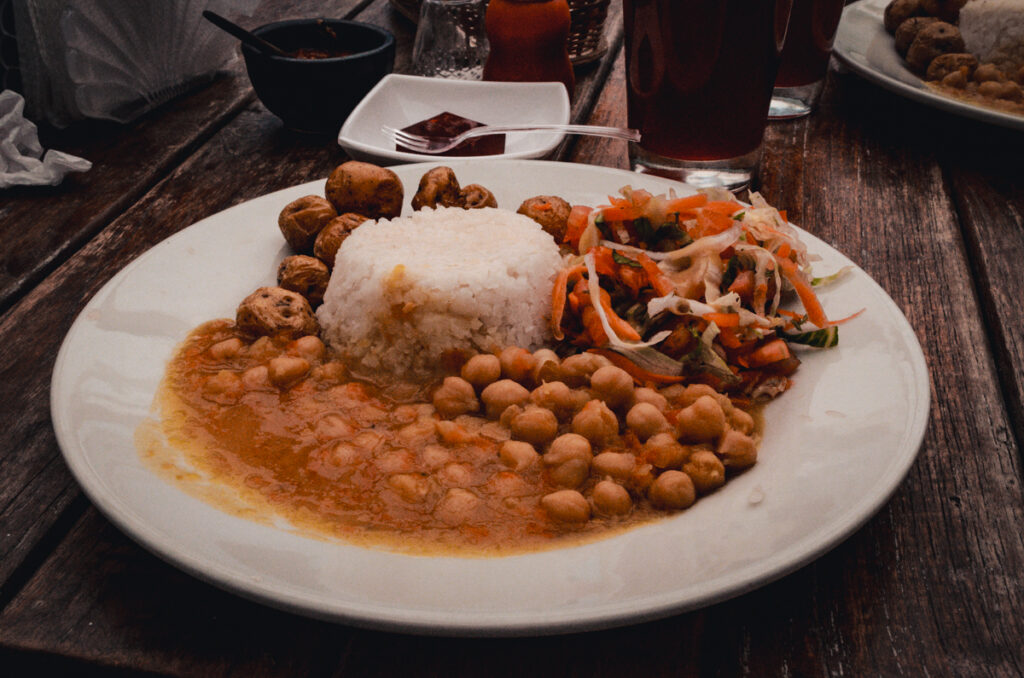
When you order a menu del dia as a vegan at a regular Colombian restaurant, they usually serve you the same dish as they would to the other guests minus the meat or fish.
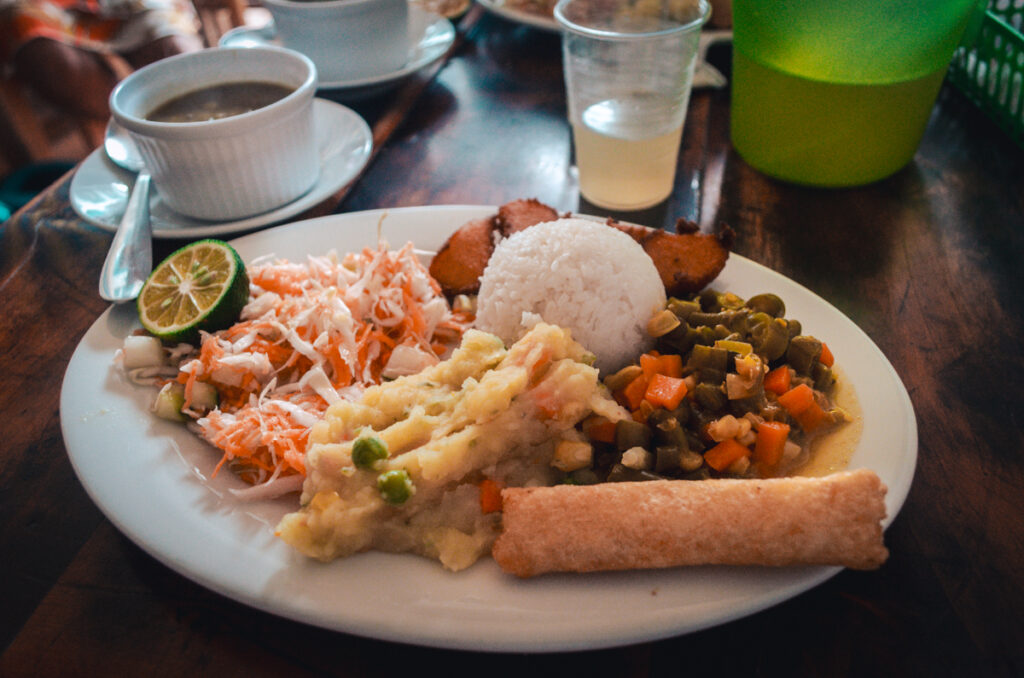
This is usually very rich in nutrients as it always contains beans and lentils which are good for protein but it is also often very heavy on carbs, which is not always ideal if you are trying to keep of weight.
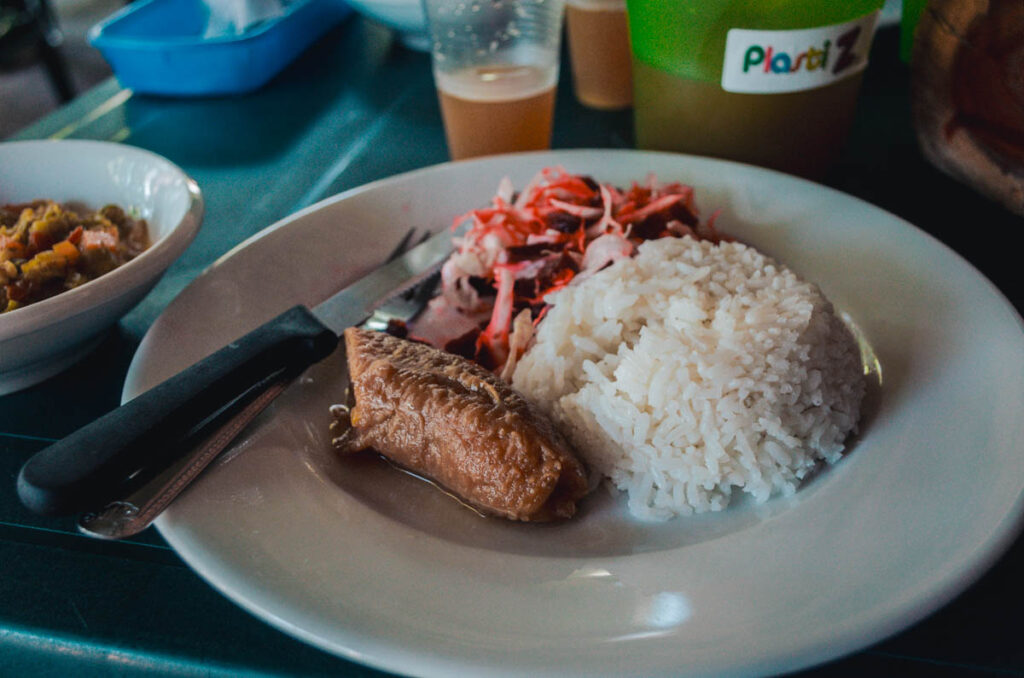
Generally, they are also very accommodating if you ask to include another dish that isn’t advertised on the menu of the day, like fries or baked potatoes instead of rice or an extra salad.
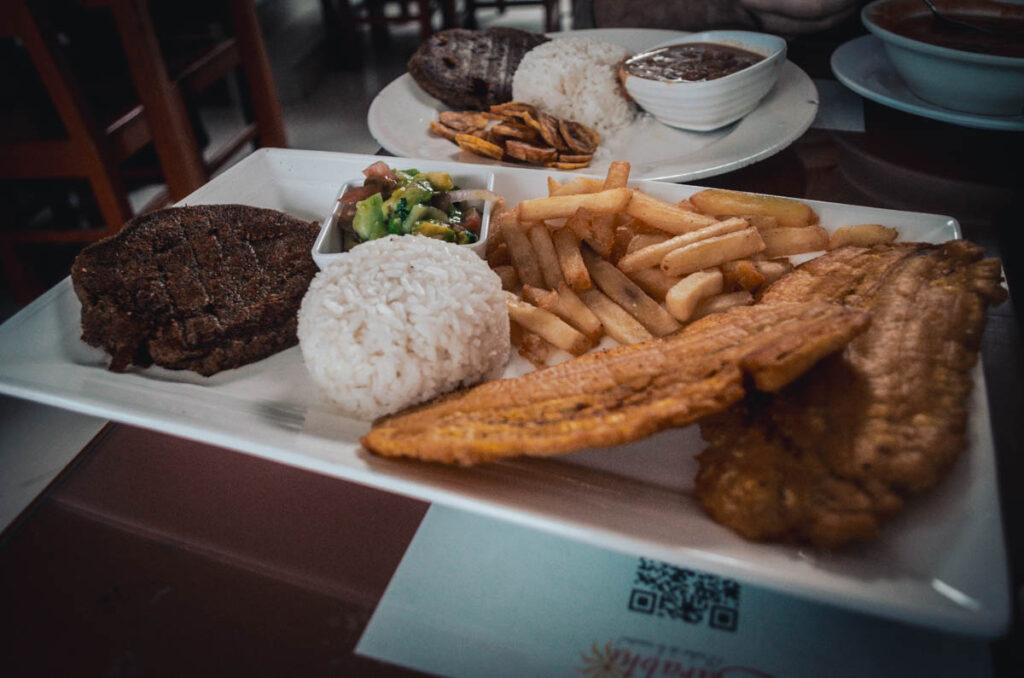
While nutritious and overall healthy, what I found to lack sometimes was a little more variety in spices and vegetables. Luckily, some restaurants also love to get creative when they receive vegan guests!
For instance, at a local restaurant in Minca, we were served grilled eggplant for lunch which was a nice change from the beans and salads.
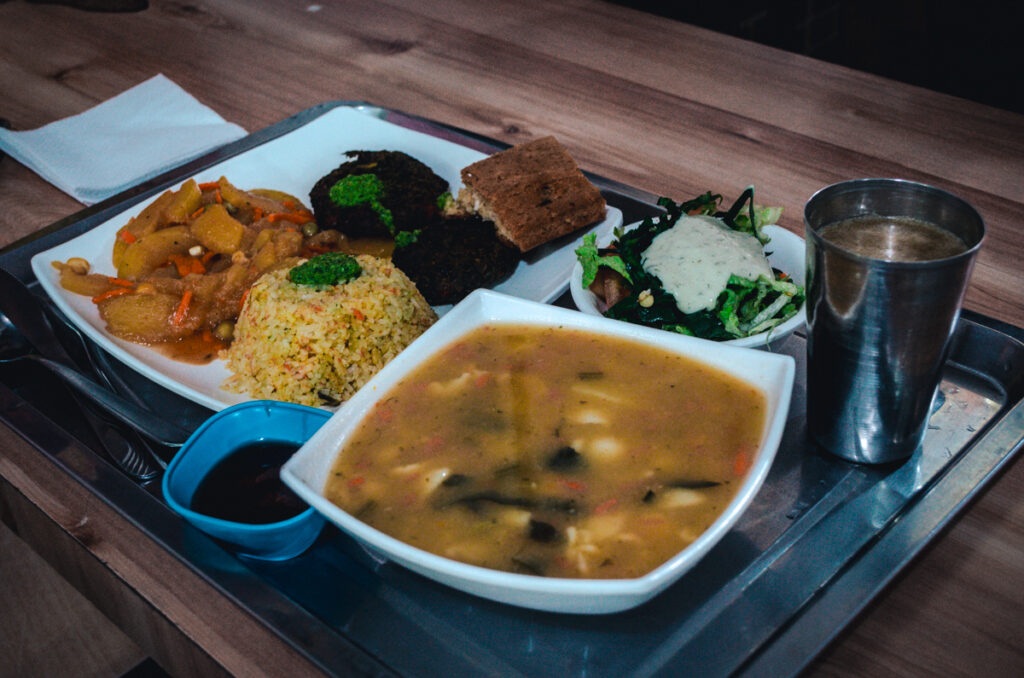
Menu del Dia at Govindas vegan restaurant, Bogota, Colombia
A menu del dia at a vegan restaurant in Colombia essentially is the same as at a regular restaurant but the meal will be more balanced out and you will get an extra source of protein that replaces the meat.
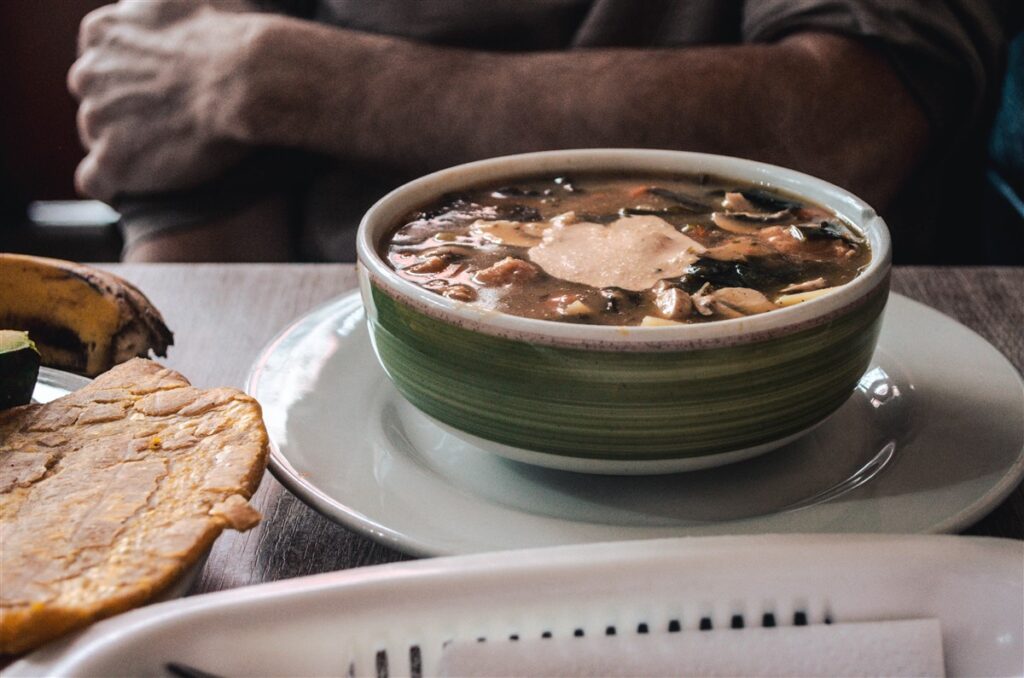
Delicious soup with seaweed at Loto Azul Vegano in Bogota
The meals will generally also contain more vegetables and even include other ingredients that are great nutritional sources for vegans like seaweed added to soup or brown rice instead of plain white rice.
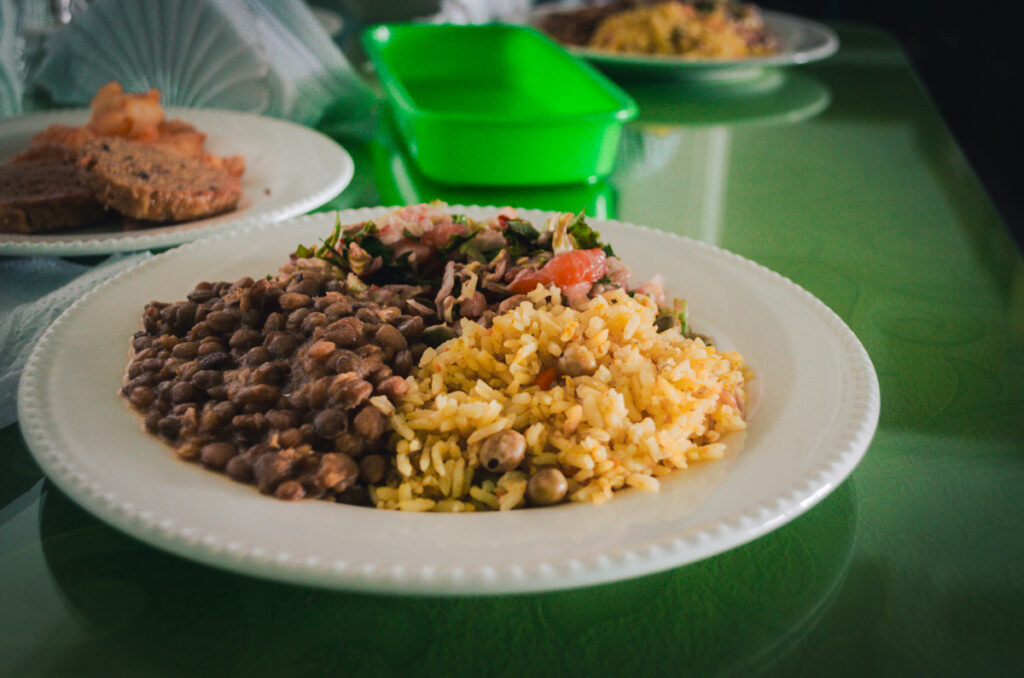
San Gil- Trygo y Miel- rice with chickpeas, lentil stew, salad and vegan roast on the side
Instead of just red beans in sauce, these restaurants also tend to be much more creative and add chickpeas to the rice, prepare delicious stews with beans and vegetables, or lovely seasoned lentil dishes with extra protein.
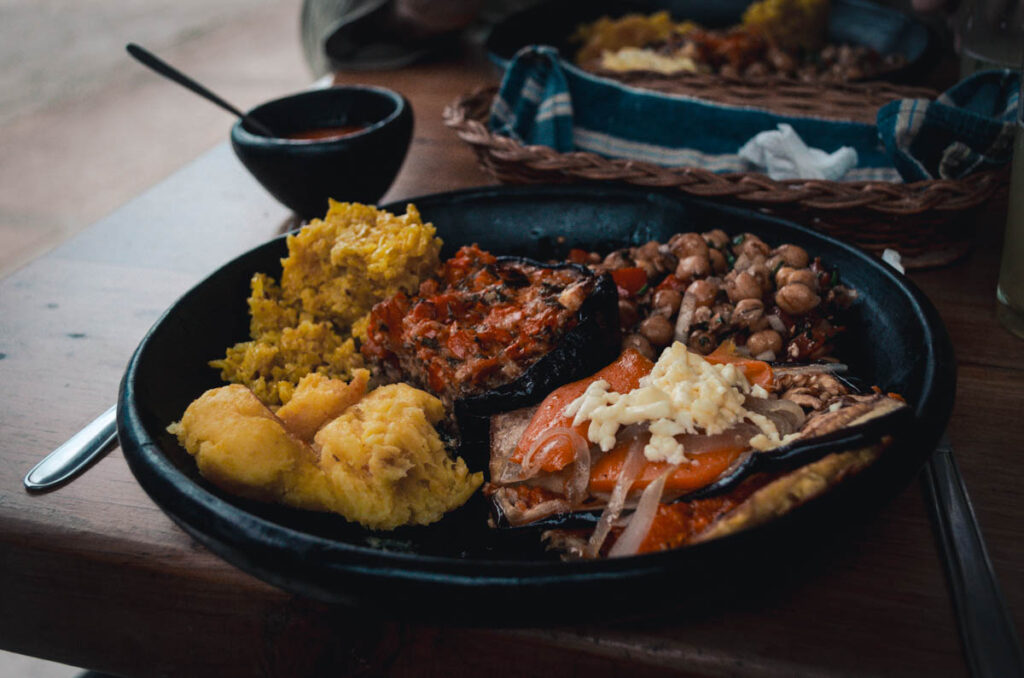
My favorite meal during my whole trip through Colombia at Tomate restaurant in San Agustin
If you are going to San Agustin to visit the San Agustin Archaeological Park, a restaurant that you have to try is Tomate. It is located in the center of San Agustin on the way to the Archaeological Park and it was the best plant-based restaurant I visited in Colombia.
It serves Colombian cuisine but sometimes with an Italian touch!
Lunch is the main meal in Colombia, which translates to restaurant opening hours that differ a bit from what we are used to in Europe. While restaurants are open until 11 P.M. in general in my home country, Belgium, most of them close very early in Colombia.
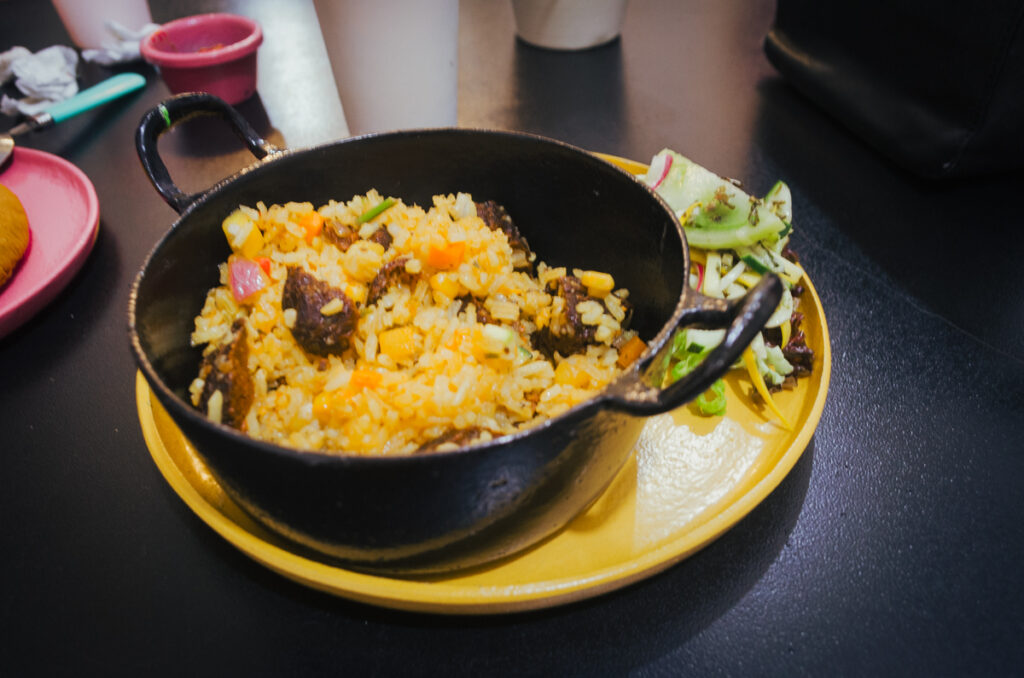
Arroz Attolado at Maria Candela vegan restaurant in Bogota
In general, it’s hard to find a Colombian restaurant open after 8 P.M. and most of the time, they close at 5 P.M. and are not open for dinner at all. This is especially true for non-touristy areas or outside of the big cities.
What does come alive in the evening in certain locations is the street food culture and, since Colombians like to have a light meal in the evening, this is the place you should look for food.
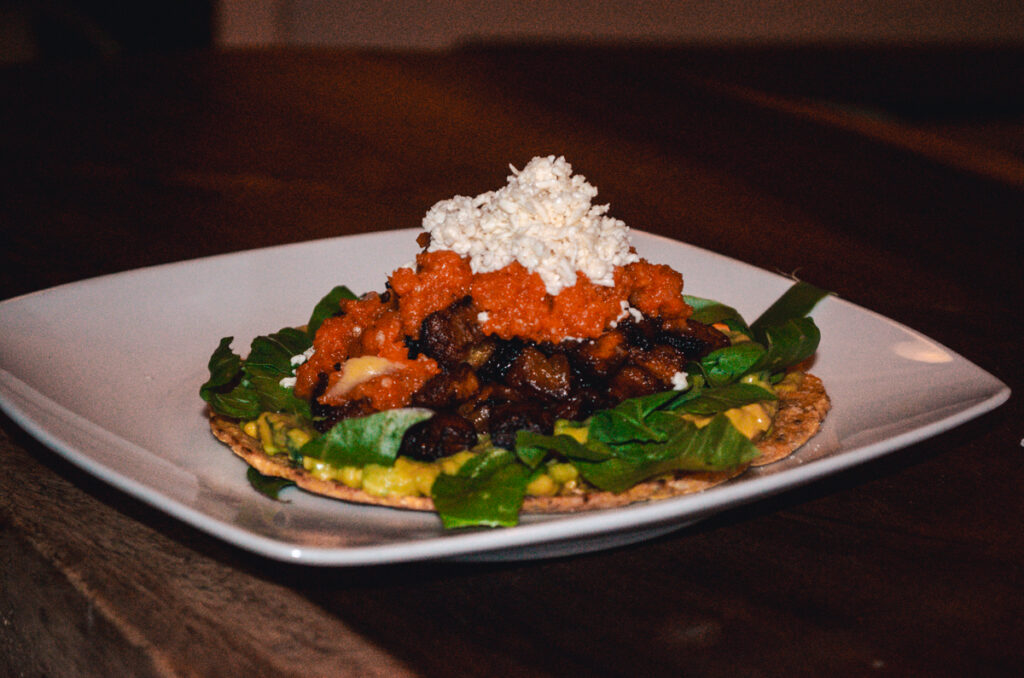
Vegan arepa at Duni Cafe, Minca
However, in big cities and touristy areas, you will be able to find vegan Colombian food because the restaurant’s owners see some benefit in adapting to the wishes of tourists who like to dine out in the evening.
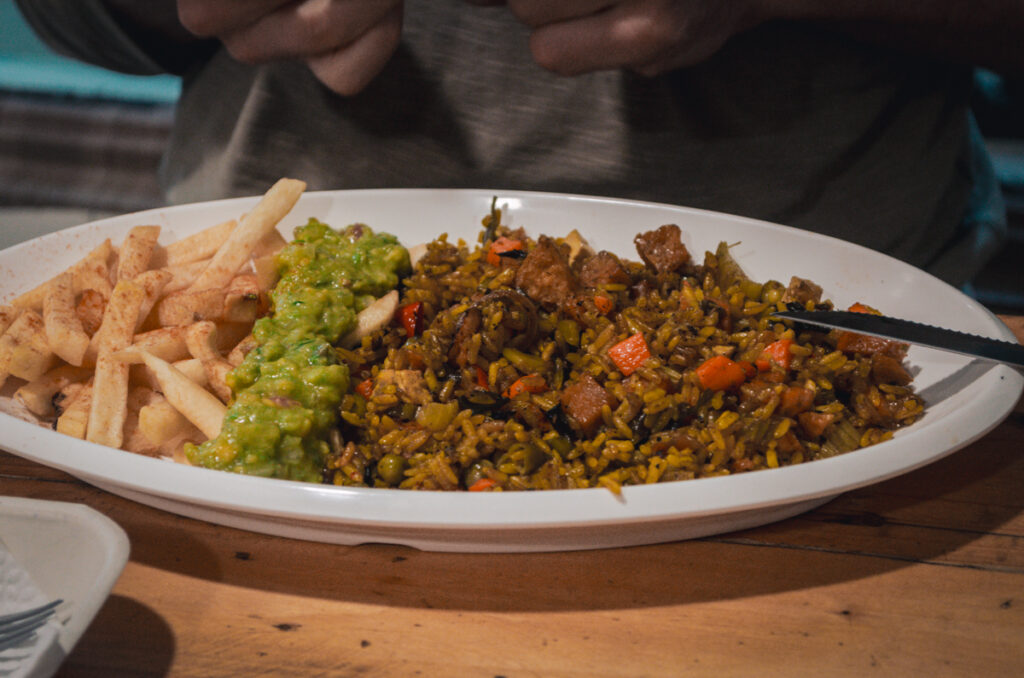
Paella with fries
We were able to find a few local spots that were open in the evening serving Colombian fare but this was minimal and was mostly in very touristy areas.
If you don’t fancy going to a pricey tourist restaurant instead, note that most small guesthouses in Colombia come with a communal kitchen that is free to use. We loved to stock up on fresh ingredients at the local Colombian markets and prepare a healthy meal for ourselves in the evening.
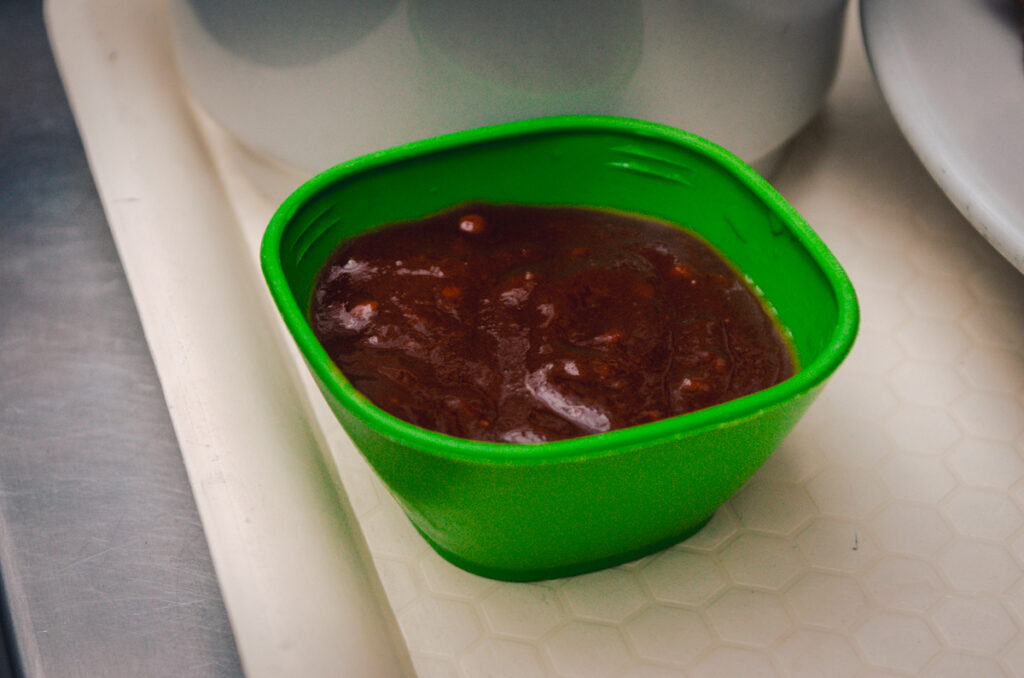
Fruit jam as dessert at Pino Negro in Bogota
Vegan desserts are hard to come by in traditional Colombian restaurants. Most of them contain milk, condensed milk, or eggs, like obleas and torta de tres leches.
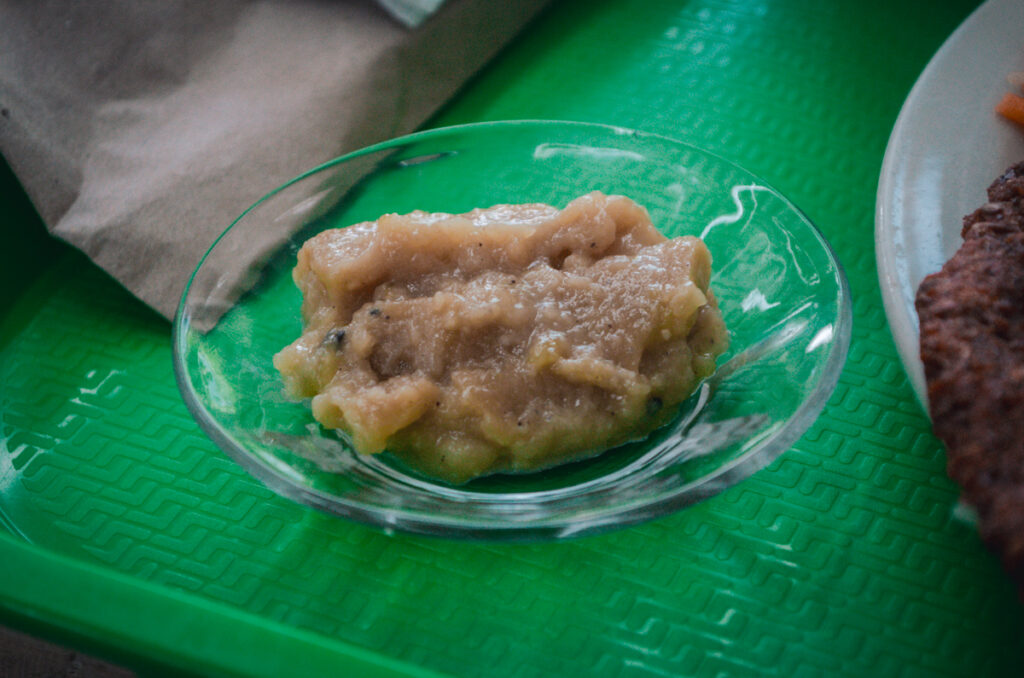
A sort of vegan arequipe dessert with chucks of coconut at Las Veganas in Medellin
However, if you have a sweet tooth, there’s one naturally vegan dessert-like type of sweet that you might like. It is called bocadillo and it’s a sweet made from guava pulp mixed with sugar or panela.
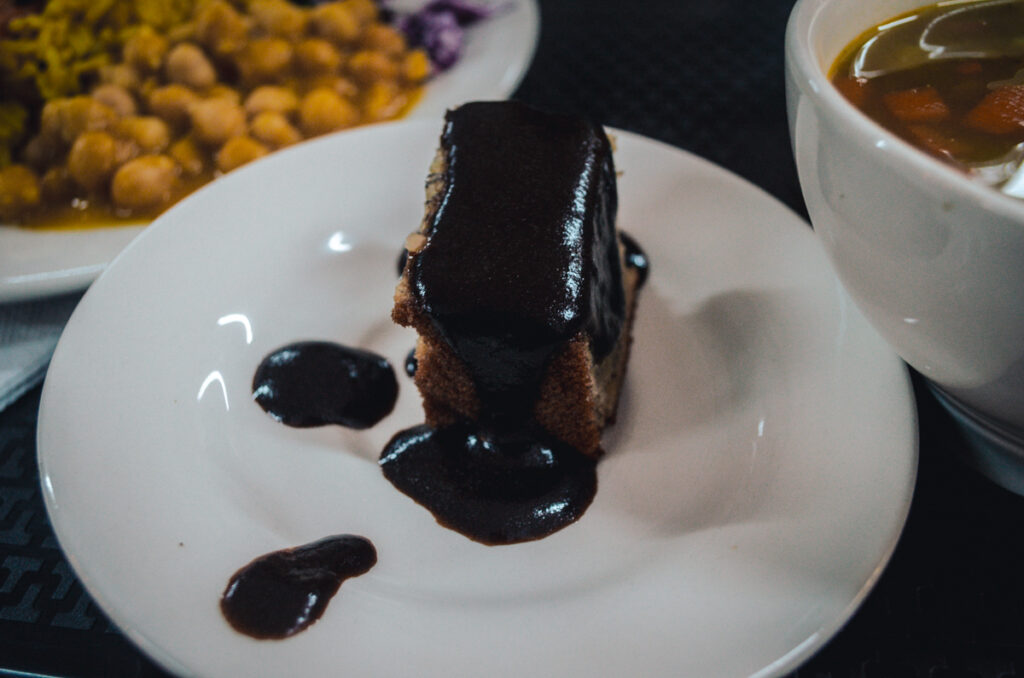
Vegan banana cake with chocolate at Pita’s buffet in Medellin
Bocadillo can be found sold on the street. It has a dark red color, and a rectangular shape and it is traditionally wrapped in bijao plant leaves to preserve it. Watch out if there’s an added white layer to your bocadillo. This is cheese!
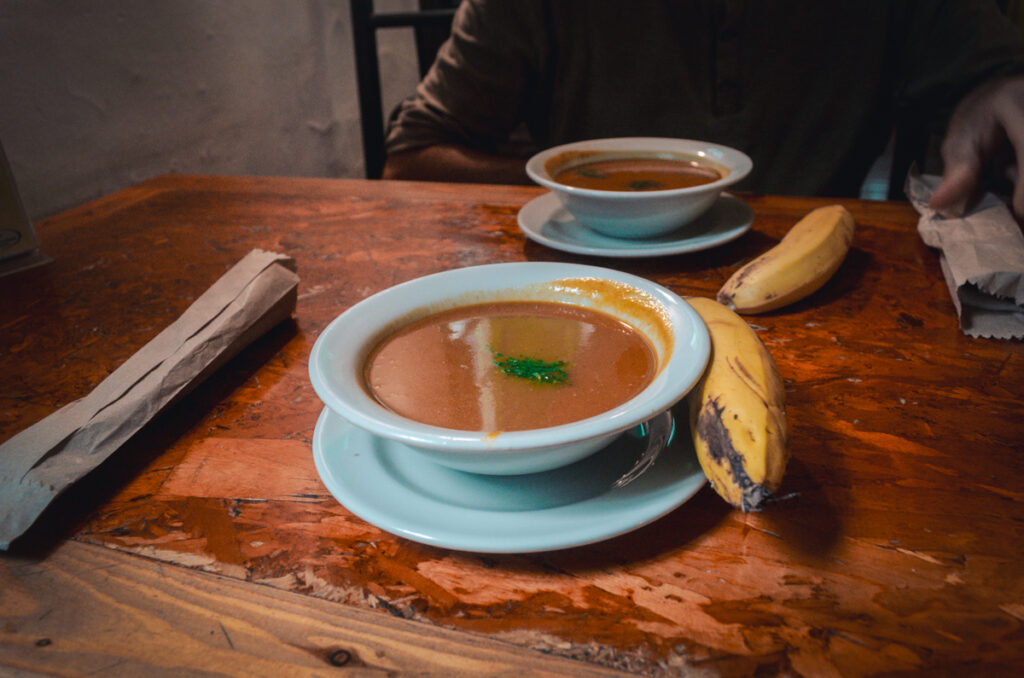
Just a banana as dessert
The only vegan dessert I was able to eat at traditional Colombian restaurants was fresh fruit which can come in a salad or just plain fruit like a banana. Vegan restaurants had small vegan desserts accompanying the menu del dia and ranged from small cakes to fruit jams.
Street food is abundant in Colombia and walking the streets in the evening is a joy. Unfortunately, for vegans, there’s little street food that caters to our plant-based wishes.
Here are a few snacks that I found that were suitable for vegans. Do note that I didn’t find them at street stalls but rather at big markets and vegan restaurants.
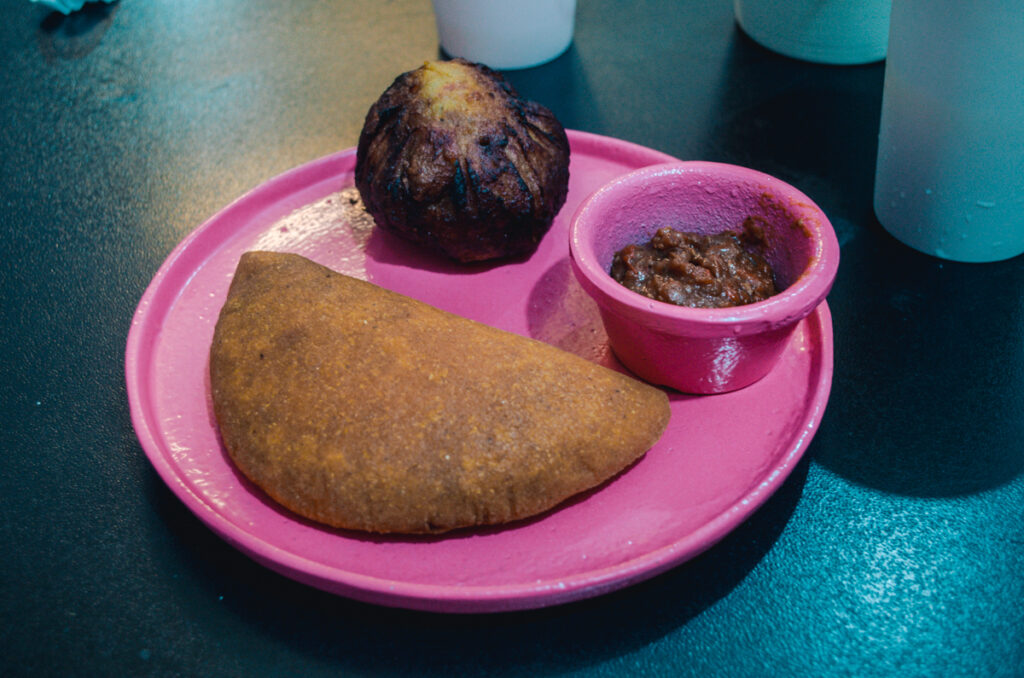
Vegan empanada at Maria Candela in Bogota
Colombian empanadas are deep-fried snacks made from corn dough and a hearty filling usually consisting of meat, potatoes and vegetables with aji, a green sauce, to top it.
I have roamed the streets of Colombia in search of a street stall that sold vegan empanadas but unfortunately, I didn’t find any. A good place to try vegan Colombian empanadas is Maria Candela Vegan in Bogota.
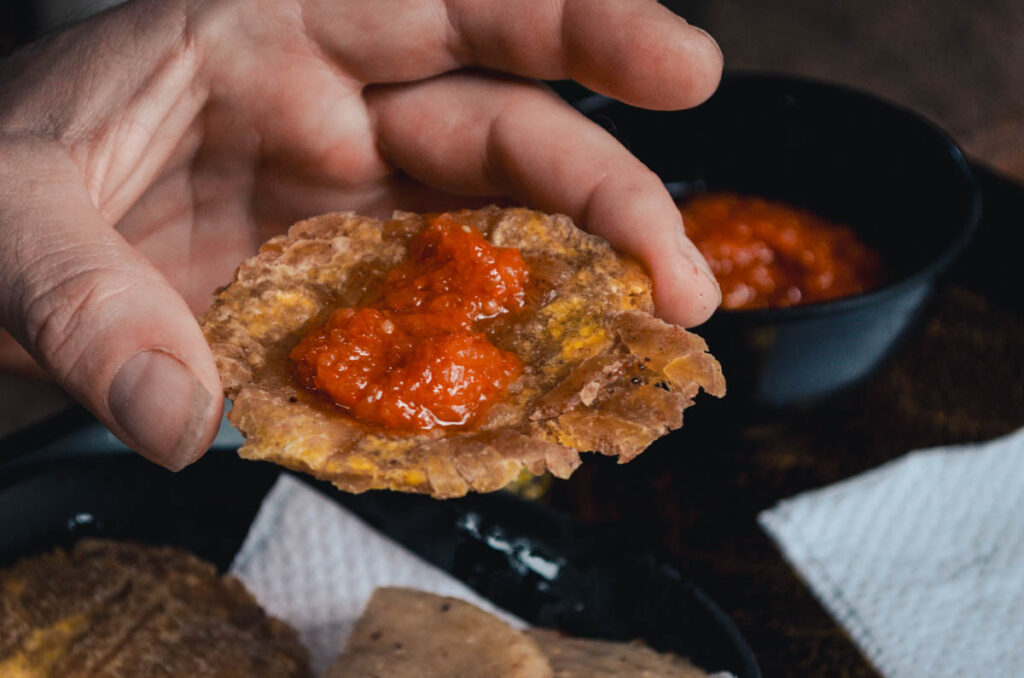
Patacones with hogao
Patacones with hogao are pieces of crisp fried plantain topped with a traditional Colombian sauce. Hogao is a red sauce made of tomato and onions flavored with garlic, cumin, salt, and sometimes fresh herbs like cilantro.
I was served this delicious naturally vegan Colombian snack on a coffee tour in Salento.
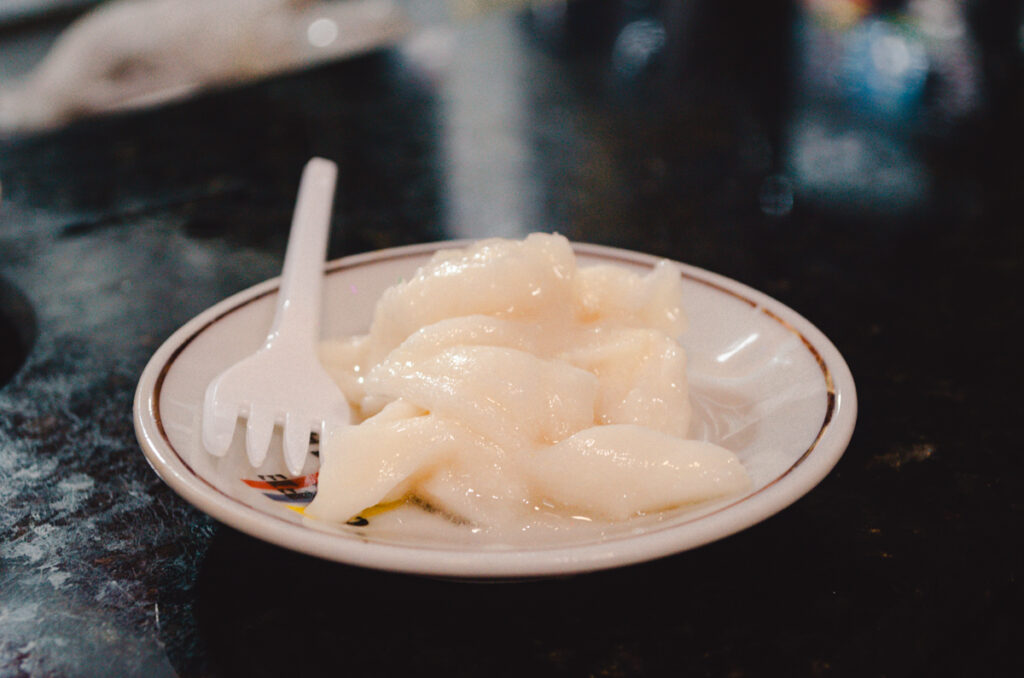
Fresh soursop at Casa de Mercodo in San Gil
Fruit stalls are abundant in Colombia. You can find a lot of snacks on the street containing fruit, from tropical colorful drinks to small portions of fruit like soursop, mango, or chontaduro.
A lovely drink to try, especially when you are in Cali, is Lulada. This is a tropical, naturally vegan drink made from Lulo fruit, lime juice, sugar, and water.
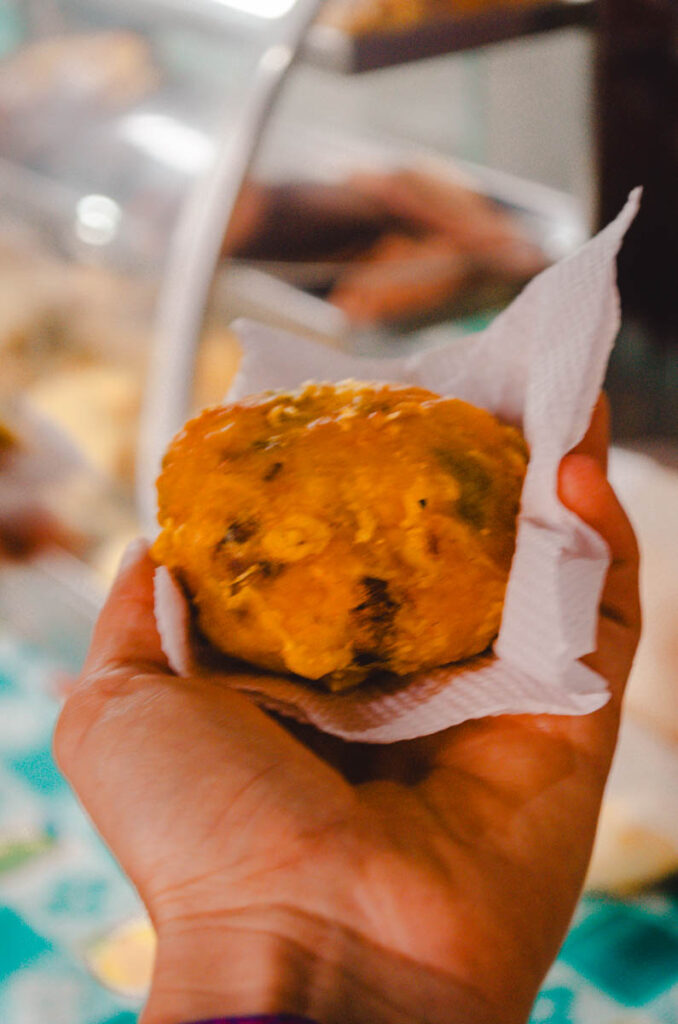
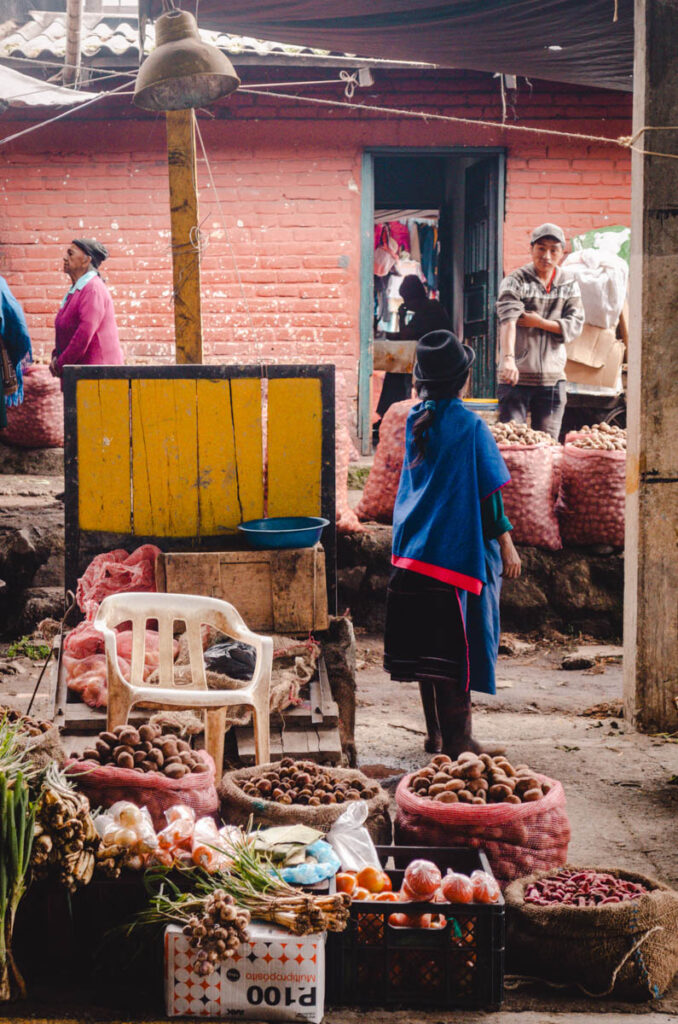
Fried rice balls and local Guambiano women at the Silvia market
Afer scourcing the streets of big cities like Medellin and Bogota for a vegan version of a Papa Rellena, I couldn’t believe I found this vegan street snack in the mountains of Silvia on the Guambiano market.
While it wasn’t a Papa Rellena, it was a delicious fried rice ball with vegetables topped with a tangy green sauce. At first, I was a little scared that the Tuesday market in Silvia would’ve turned into a tourist attraction but this is not the case.
Include it in your Colombia itinerary if you are interested in learning about the hill tribes of Colombia (and vegan rice balls!:)).
Colombia offers a wide selection of drinks suitable for people on a vegan diet. Here are some popular Colombian drinks that are vegan-friendly!
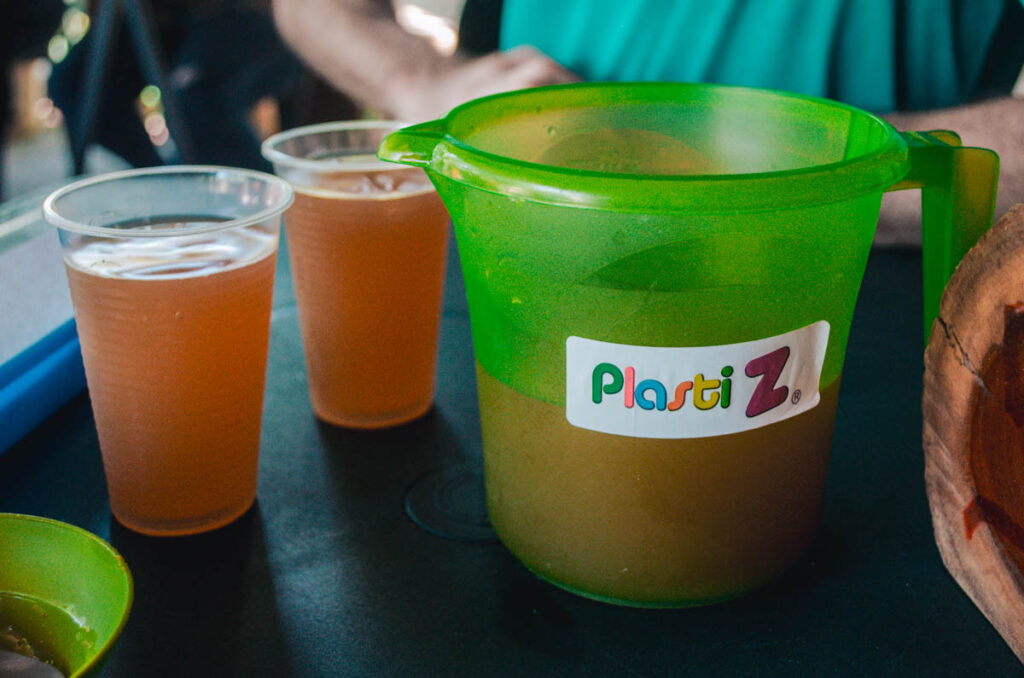
Aguapanela
Aguapanela is a traditional Colombian drink that is made by dissolving panela (unrefined whole cane sugar) into water. It can be served hot or cold and comes with a dash of lemon juice of extra flavor.

Tinto is the Colombian term for black coffee and is a staple in Colombian culture. While Colombia is one of the most famous distributors of coffee, the locals themselves benefit little from this wonderful product.
Tinto is often made from bad-quality leftover beans that can’t be used for export and comes with a lot of sugar to cover up the bad taste. However, good organic coffee is on offer too.
A Colombian aromatica is a herbal tea that contains a blend of various herbs, fruits, and sometimes even flowers. It can be served hot or cold and is sometimes sweetened with panela.

Vegan Colombian hot chocolate
Hot chocolate is a cultural staple in Colombia and it’s often enjoyed as a part of breakfast together with arepas, cheese, and eggs. Hot chocolate is not naturally vegan in Colombia as is contains milk but vegan varieties are for sale at vegan restaurants.
Fresh juices or “Jugos Naturalles” in Spanish are widely available and popular in Colombia due to the abundance of fresh fruit in the country. Juices can be made with water or milk and you can pick from a wide range of options, from mango to papaya or passion fruit.
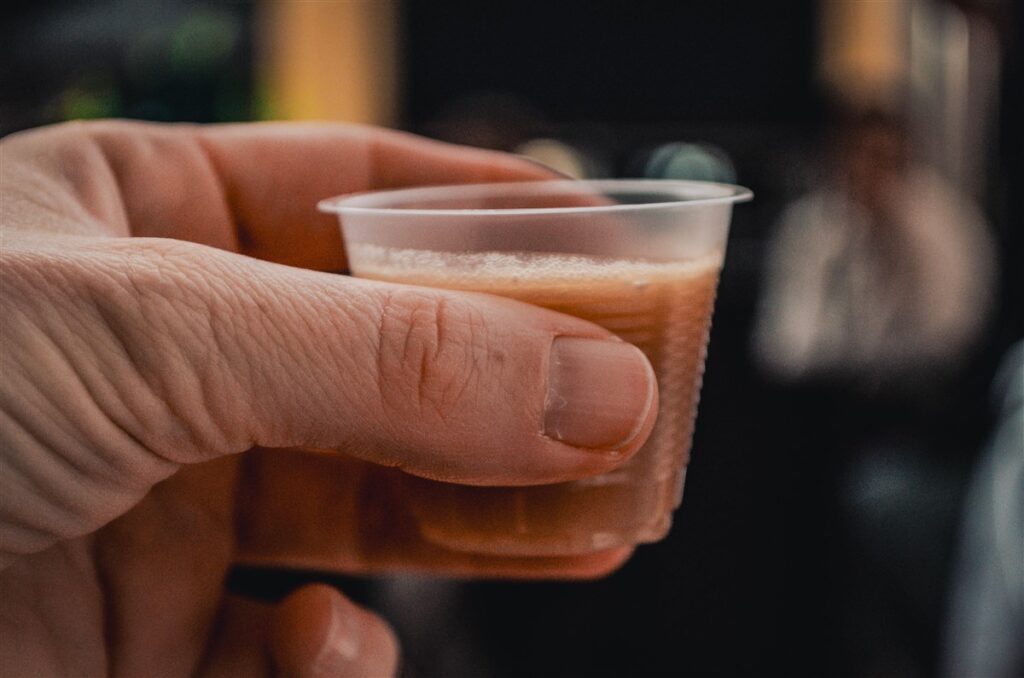
Chicha is a traditional Colombian fermented beverage that has deep roots in its indigenous culture. It is usually made from corn and contains a small percentage of alcohol.
Chicha production has been subjected to legal restrictions in Colombia mainly due to health concerns but it can still be found in some parts of the country.
Aguardiente is a popular alcoholic drink in Colombia and is widely consumed during celebrations and social gatherings. It has a distinct flavor coming from anise seeds which give it a sweet licorice taste.
It is often consumed as an addition to a cup of hot aguapanela or as ‘canelazo’ with fruit juice, mint, and cinnamon.
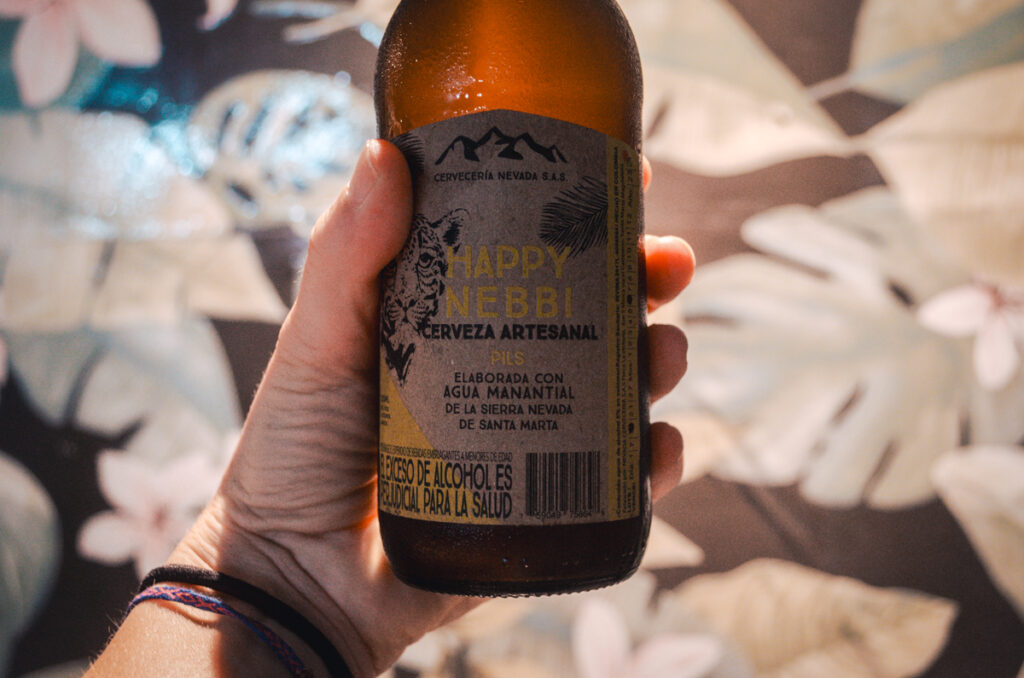
Happy Nebbi beer from Cerveceria Nevada in Minca
Beer is another staple beverage in Colombia just like in many countries worldwide. The most famous brands are Poker, Aguila, and Club Colombia but there’s also an amazing growing craft beer scene is Colombia!
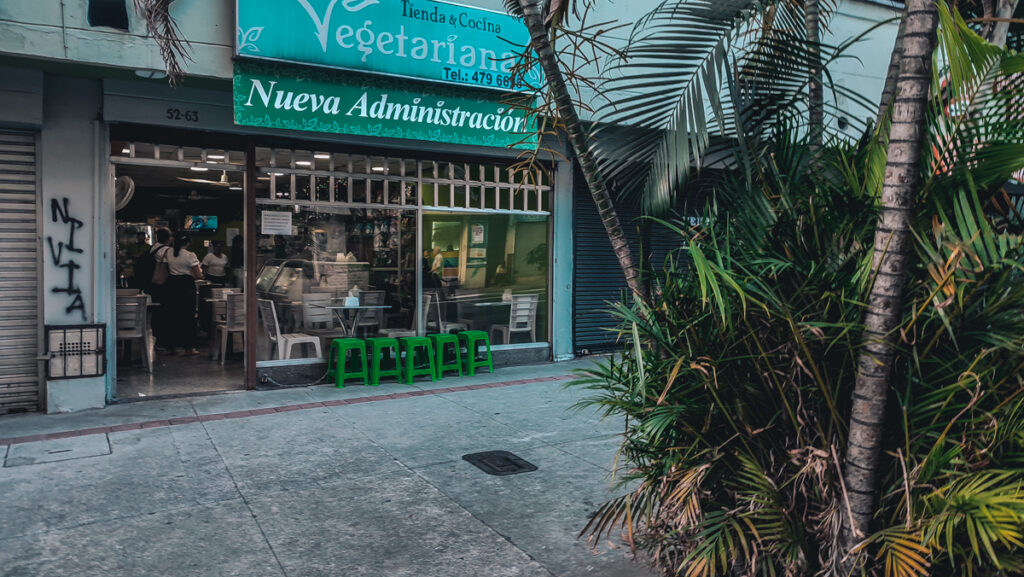
Vegan restaurants are easy to find in large cities like Medellin, Bogota, and Cartagena but there are also some gems to be found in smaller cities and cute little towns.
Here are my restaurant recommendations for traditional vegan food in Colombia!
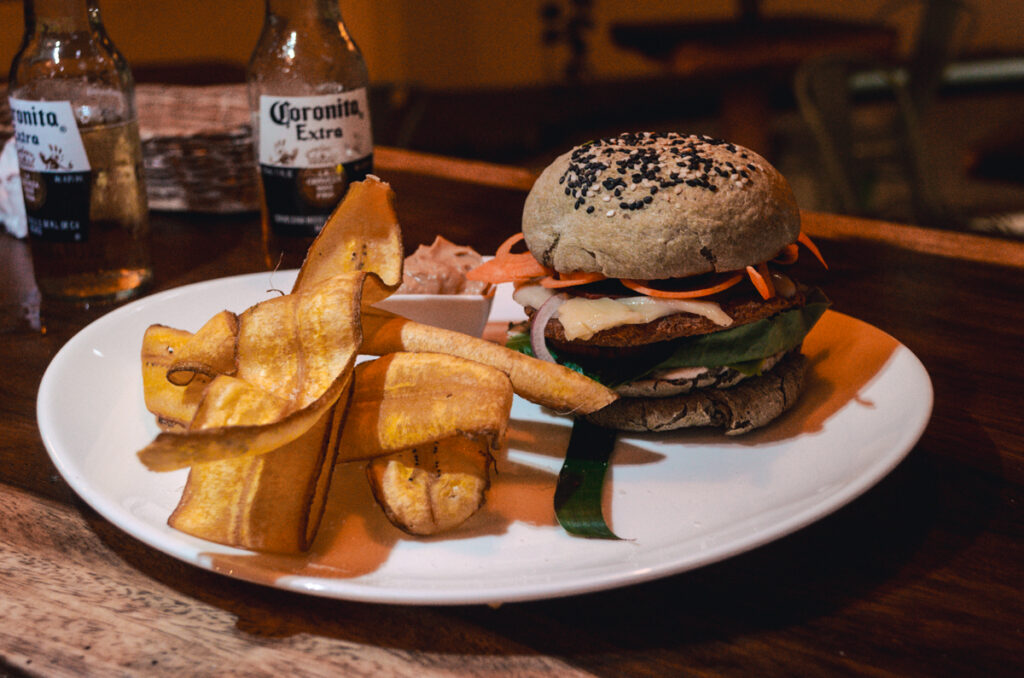
Vegan burger @ Duni in Minca
Vegan Colombian food is widely available but sometimes, you might long for something else than rice and beans. Don’t worry, Western food is widely available in Colombia and it’s what most travelers turn to in the evening when most Colombian restaurants close down for the day.
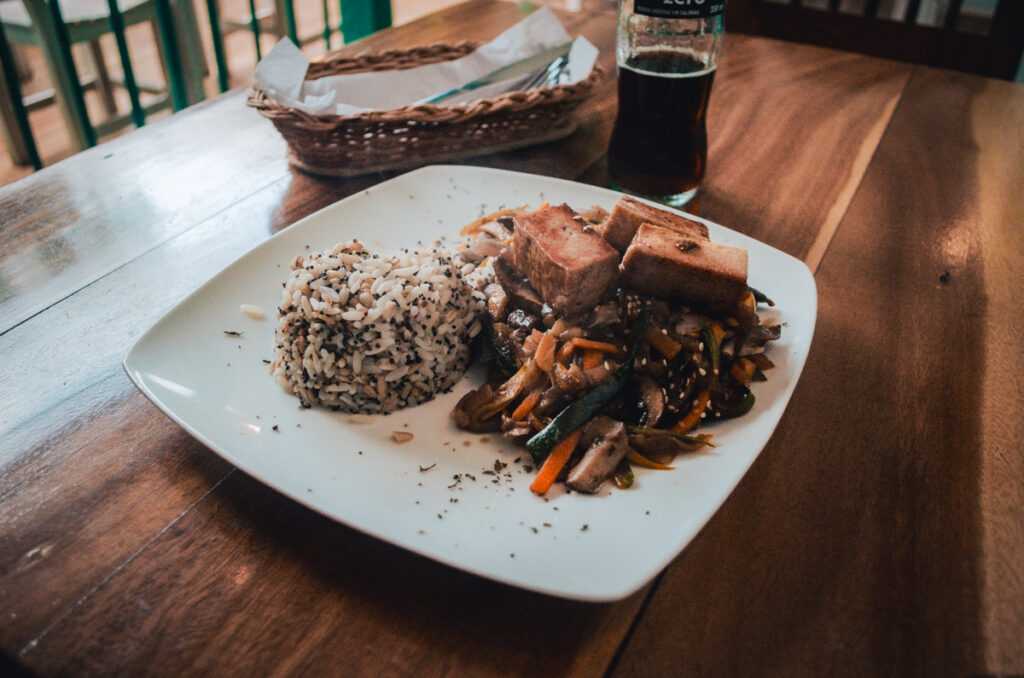
Vegan oriental dish @ Serendipia in Salento
In areas that cater to tourists, you can find anything from pizza and pasta to Asian cuisine and arab inspired food. Mexican food is also widely available and most Western-style restaurants can easily veganize their dishes to suit your needs.
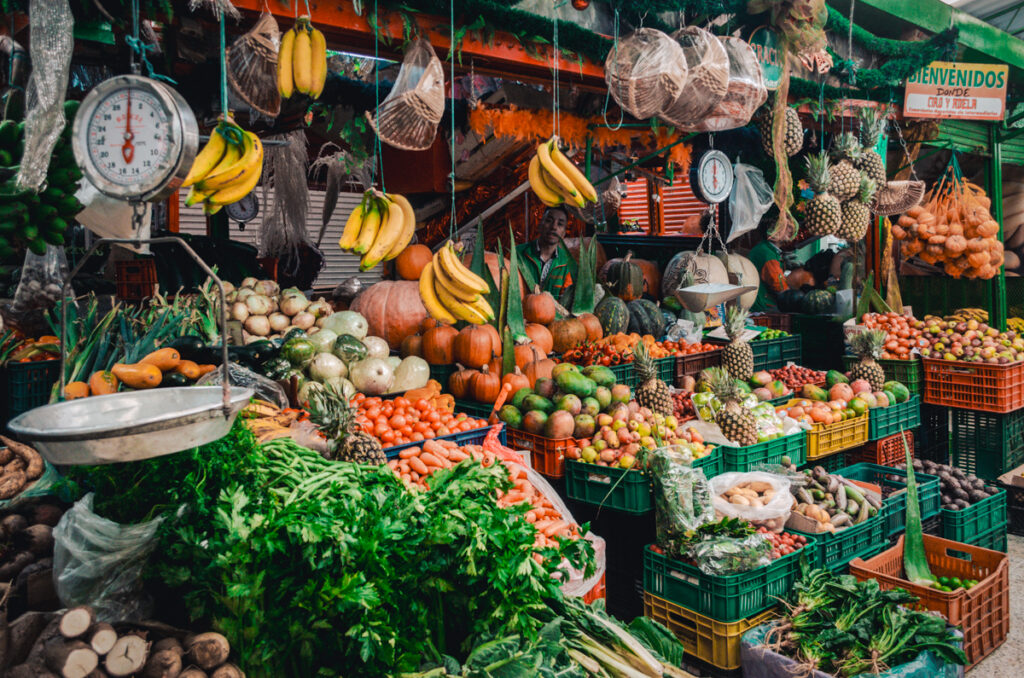
Vendor at the Paloquemao Market in Bogota
Yes, vegan food is widely available in Colombia, both in supermarkets and on local markets. Tropical fruits and a large variety of vegetables can be bought at markets like the excellent Paloquemao Market in Bogota. They are also easily found at smaller markets in places like San Gil or Villa de Leyva.
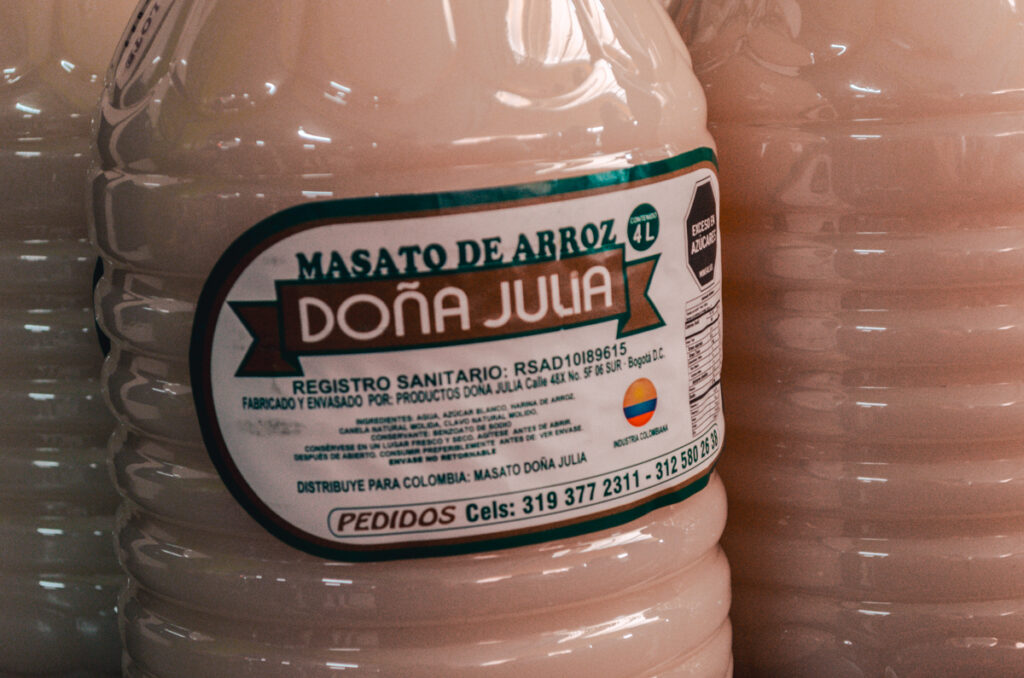
If you are looking for plant-based milk, look out for Masato de Arroz, a locally brewed rice milk that will be cheaper than buying plant-based milk in a supermarket.
Supermarkets offer a large array of plant-based milks but they are expensive for Colombian Standards. Tofu is also available at supermarkets, same as nuts, seeds, oats, pasta, beans and rice.
Even though Colombian cuisine is meat-heavy there are surprisingly many accommodation options in Colombia that cater to vegans. They often also operate as an eco guesthouse or resort and sometimes include yoga classes.
MINCA:
JARDIN:
GUATAPE:
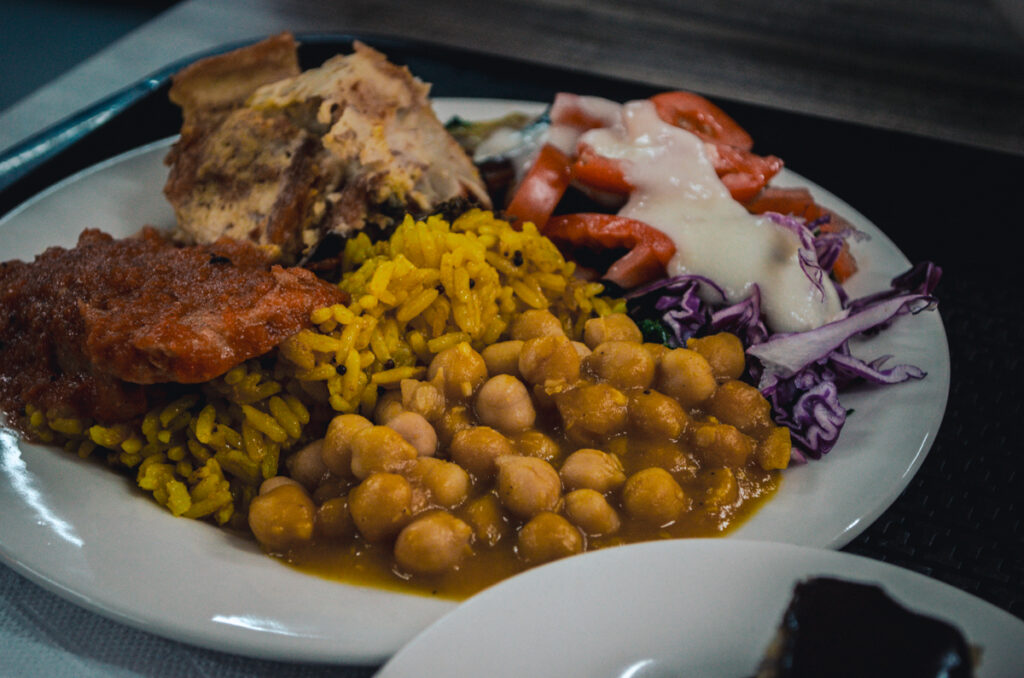
There you go! I hope you enjoyed this guide to vegan Colombian food. Let me know in the comments below if you have any questions or drop me a message through my contact page.
Also, don’t forget to check out my resources page with my favorite booking platforms and tips to start planning your trip. Additionally, have a look at my favorite travel gear if you want to pack more consciously!
ENJOY!
Disclaimer: This post may include affiliate links. If you click on them, I may receive a commission at no extra cost to you.

Hi! I am Annelies and this is Travelers & Dreamers, a blog about conscious travel which means traveling in a more mindful way, with a positive impact on the world and yourself!
On this website, I cover different topics like slow travel, plant-based food guides, responsible travel, sustainable packing, eco-travel, and more!
Latest Posts

15 Best Things to Do in Nong Khiaw, Laos (2024)
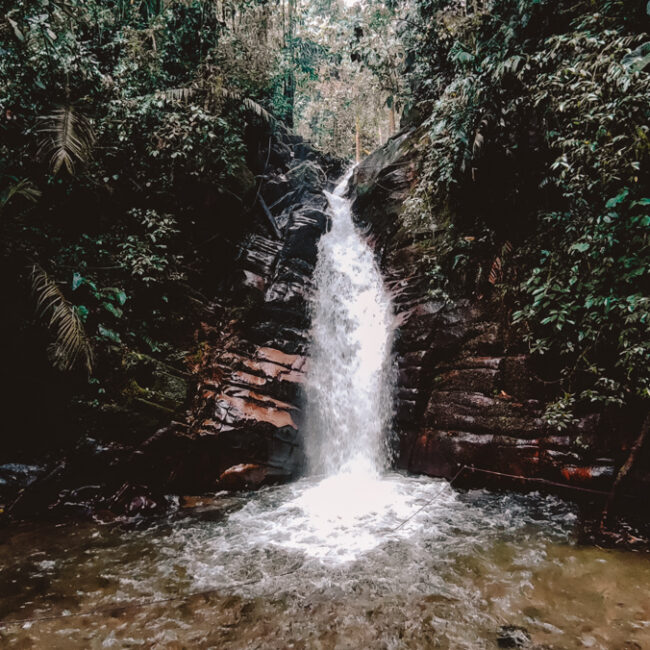
Santa Rita, Salento: All You Need to Know
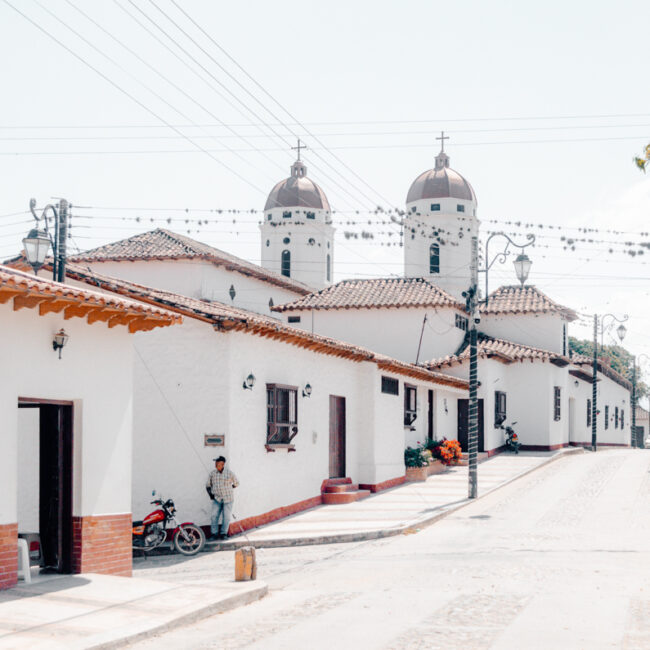
La Playa de Belen, Colombia: An Easy Travel guide!
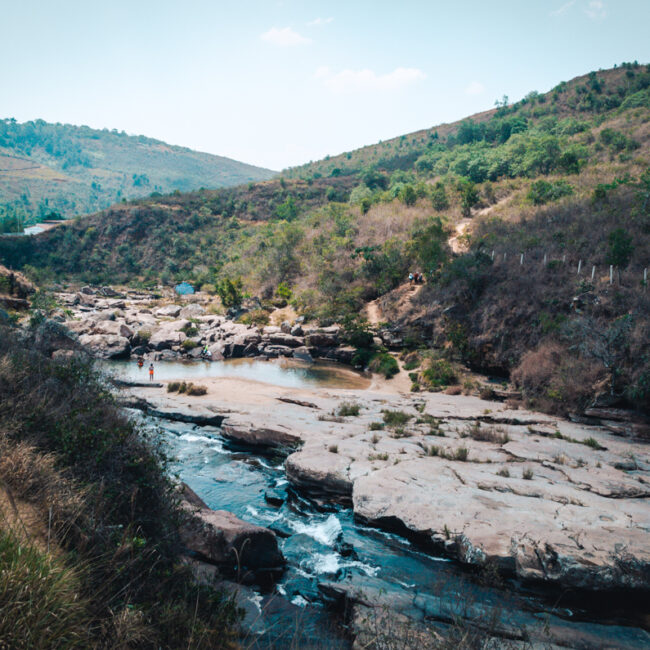
How to Visit the Pescaderito in Curiti (Near San Gil)

Los Estoraques Unique Natural Area: An Easy Travel Guide
Do you want to receive my latest finds on conscious and sustainable travel directly to your inbox? Subscribe here!
© COPYRIGHT TRAVELERS&DREAMERS, 2023.